Samsung Electronics Co 705SC Single-Band PCS GSM/ EDGE Phone with Bluetooth User Manual
Samsung Electronics Co Ltd Single-Band PCS GSM/ EDGE Phone with Bluetooth Users Manual
Users Manual

World Wide Web
http://www.samsungmobile.com
Printed in Korea
Code No.:GH68-xxxxxA
English (EU). 08/2006. Rev. 1.0
*
Depending on the software installed or your service provider or country, some of the descriptions
in this guide may not match your phone exactly.
* Depending on your country, your phone and accessories may appear different from the
illustrations in this guide.

705SC
User’s Guide
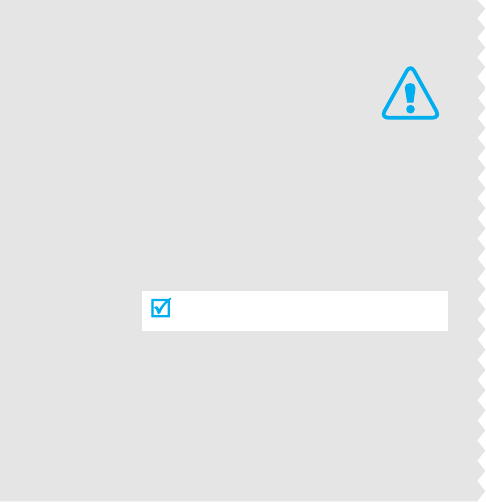
Important
safety
precautions
Failure to comply with the following
precautions may be dangerous or illegal.
Use road safety at all times
Do not use a hand-held phone while driving.
Park the vehicle first.
Switch off the phone when refuelling
Do not use the phone at a refuelling point
(service station) or near fuels or chemicals.
Switch off in an aircraft
Wireless phones can cause interference.
Using them in an aircraft is both illegal and
dangerous.
Switch off the phone near all medical
equipment
Hospitals or health care facilities may be
using equipment that could be sensitive to
external radio frequency energy. Follow any
regulations or rules in force.
Interference
All wireless phones may be subject to
interference, which could affect their
performance.

1
Important safety precautions
Be aware of special regulations
Meet any special regulations in force in any area and
always switch off your phone whenever it is
forbidden to use it, or when it may cause
interference or danger.
Water resistance
Your phone is not water-resistant. Keep it dry.
Sensible use
Use only in the normal position (held to the ear).
Avoid unnecessary contact with the antenna when
the phone is switched on.
Emergency calls
Key in the emergency number for your present
location, then press .
Keep your phone away from small children
Keep the phone and all its parts, including
accessories, out of the reach of small children.
Accessories and batteries
Use only Samsung-approved batteries and
accessories, such as headsets and PC data cables
.
Use of any unauthorised accessories could damage
you or your phone and may be dangerous.
Qualified service
Only qualified service personnel may repair your
phone.
For more detailed safety information, see "Health
and safety information" on page 90.
• The phone could explode if the battery is replaced
with an incorrect type.
• Dispose of used batteries according to the
manufacturer’s instructions.
At very high volume, prolonged listening to
a headset can damage your hearing.
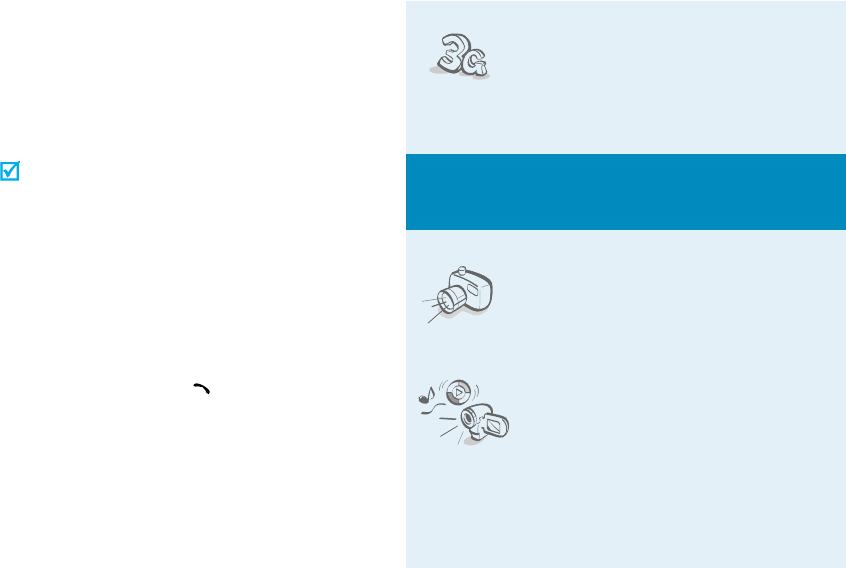
2
About this Guide
This User’s Guide provides you with condensed
information about how to use your phone. To quickly
learn the basics for your phone, please refer to “Get
started” and “Step outside the phone.”
In this guide, the following instruction icons appear:
Indicates that you need to pay careful
attention to the subsequent
information regarding safety or phone
features.
Indicates that you can get more
information on the referenced page.
→
Indicates that you need to press the
Navigation keys to scroll to the
specified option and then select it.
[
] Indicates a key on the phone.
For example,
[]
<
> Indicates a soft key, whose function is
displayed on the phone screen. For
example, <
Select
>
•3G
Your phone is capable of operating
in a 3G environment, allowing
much greater data transfer speed,
video streaming, and video
conferencing.
Special
features of your phone
• Camera and camcorder
Use the camera module on your
phone to take a photo or record a
video.
•Media player
Play media files on your phone. You
can enjoy high quality videos and
music.

Special features of your phone
3
•Bluetooth
Transfer media files and personal
data and connect to other devices
using free, wireless Bluetooth
technology.
• File viewer
Open documents in various formats
on the phone without corruption.
•Web browser
Access the wireless web to get
up-to-the-minute information and
a wide variety of media content.
• Get personal with photo caller
ID
See who’s calling you with their
very own photo displays.
• Name card
Create name cards with your
number and profile. Whenever
introducing yourself to others, use
this convenient electronic name
card.
• Multimedia Message Service
(MMS)
Send and receive MMS messages
with a combination of text, images,
video, and audio.
•E-mail
Send and receive e-mails with
image, video, and audio
attachments.
•Java
Enjoy Java
™
-based embedded
games and download new games.
• Organiser
Keep track of your daily, weekly,
and monthly schedule.
• Voice recorder
Record memos or sounds.
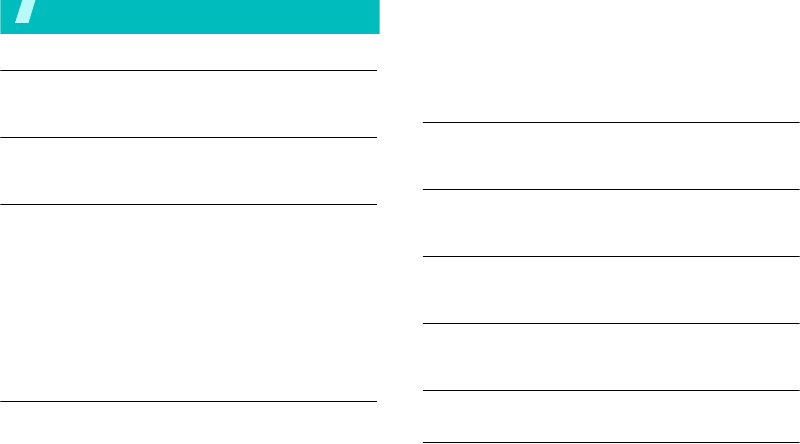
4
Contents
Unpack 6
Make sure you have each item
Your phone 6
Keys, features, and locations
Get started 7
First steps to operating your phone
Install and charge the phone.............................. 7
Power on or off ................................................ 8
Keys and display .............................................. 9
Access menu functions.................................... 11
Customise your phone..................................... 12
Make/Answer calls.......................................... 14
Step outside the phone 15
Begin with your camera, the media player, the web, and
other special features
Use the camera.............................................. 15
Play media files.............................................. 16
Browse the web.............................................. 17
Use Contacts ................................................. 17
Send messages.............................................. 18
View messages.............................................. 20
Use Bluetooth................................................ 21
Use a memory card........................................ 22
Switch applications......................................... 24
Enter text 25
ABC, T9, Number, and Symbol modes
Call functions 27
Advanced calling features
Menu functions 31
All menu options listed
Solve problems 89
Help and personal needs
Health and safety information 90
Index 96

5
1 Call log
p. 31
1 Missed calls
2 Dialled calls
3 Received calls
4 Current contacts
5 Delete all
6 Data calls
7 Calls cost
1
8 Calls time
p. 31
p. 32
p. 32
p. 32
p. 32
p. 32
p. 32
p. 33
2 Contacts
p. 33
1 Search contact
2 New contact
3 Groups
4 Speed dial
5 My name card
6 Copy all
7 Own number
8 Service number
1
9 Settings
0 Memory status
p. 33
p. 34
p. 35
p. 35
p. 36
p. 36
p. 36
p. 36
p. 36
p. 36
3 Media player
p. 37
4 Internet
p. 39
1 Go to homepage
2 Enter URL
3 Bookmarks
4 Saved pages
5 History
6 Advanced
7 Browser settings
p. 39
p. 40
p. 41
p. 41
p. 41
p. 41
p. 42
5 Messages
p. 42
1 Create new
2 Inbox
3 Drafts
4 Outbox
5 Sent box
6 Email inbox
7 Media Album
2
8 Templates
9 Broadcast
0 Delete all
* Settings
# Memory status
p. 42
p. 46
p. 47
p. 48
p. 48
p. 48
p. 49
p. 49
p. 50
p. 50
p. 51
p. 55
6 File manager
p. 55
Images
Videos
Music
Sounds
Games & More
Other files
Memory card
3
p. 55
p. 57
p. 57
p. 58
p. 59
p. 60
p. 61
7 Organiser
p. 62
1 Calendar
2 Week view
3 Today’s events
4 Schedule
5 Anniversary
6 Task
7 Memo
8 Missed event alarm
9 Memory status
p. 62
p. 64
p. 64
p. 64
p. 64
p. 64
p. 64
p. 65
p. 65
8 Camera
p. 65
9 Bluetooth
p. 70
* Applications
p. 72
1 SAT
1
2 mPet
4
3 Voice recorder
4 World clock
5 Calculator
6 Converter
7 Tube map
p. 72
p. 72
p. 75
p. 76
p. 76
p. 77
p. 77
0 Alarms
p. 78
# Settings
p. 79
1 Profiles
2 Time & date
3 Phone
4 Display
5 Call
6 Connectivity
7 Application settings
8 Security
9 Memory status
0 Operator settings
2
* Reset settings
p. 79
p. 80
p. 80
p. 81
p. 82
p. 84
p. 86
p. 86
p. 88
p. 88
p. 88
1. Shows only if supported by your USIM/SIM
card.
2. Shows only if supported by your service
provider.
3. Shows only if a memory card is inserted.
4. The menu location may appear differently
depending on your service provider.
Overview of menu functions
To access Menu mode, press [
OK
] in Idle mode.

6
Unpack
Make sure you have each item
You can obtain various accessories
from your local Samsung dealer.
Phone Travel Adapter
Battery PC Data Cable
PC Link CD User’s Guide
The items supplied with your
phone and the accessories
available at your Samsung dealer
may vary, depending on your
country or service provider.
Your phone
Buttons, features, and locations
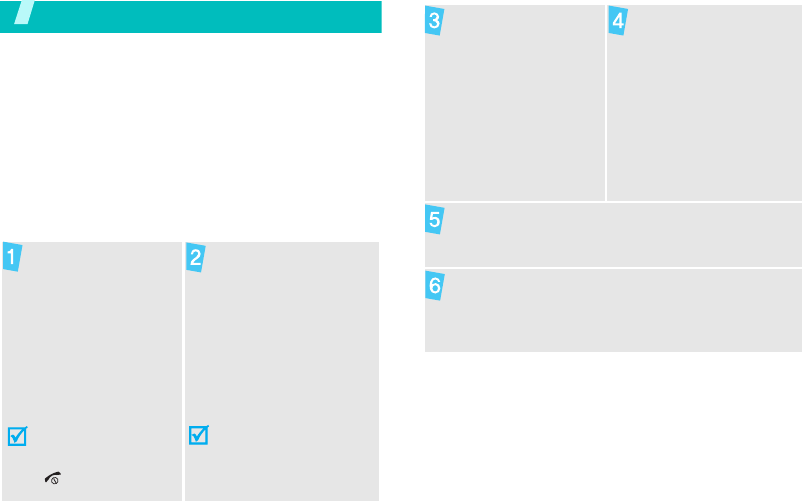
7
Get started
First steps to operating your phone
USIM/SIM card information
When you subscribe to a cellular network, you
receive a plug-in SIM (Subscriber Identity Module)
card loaded with your subscription details, such as
your PIN and available optional services. For 3G
services, you can purchase an USIM (Universal
Subscriber Identity Module) card.
Install and charge the phone
Remove the battery.
If the
phone is already
on, first turn it off by
pressing and holding
[].
Insert the SIM card.
Make sure that the gold-
coloured contacts on the
card face down into the
phone.
Install the battery.
Plug the travel adapter
into the phone.
Plug the adapter into a standard AC wall outlet.
When the phone is completely charged (the
battery icon becomes still), unplug the adapter
from the power outlet.

Get started
8
Low battery indicator
When the battery is low:
• a warning tone sounds,
• the battery low message displays, and
• the empty battery icon blinks.
If the battery level becomes too low, the phone
automatically turns off. Recharge your battery.
Power on or off
Remove the adapter from the phone.
Power on
Do not turn on
the phone when
mobile phone use
is prohibited.
1. Open the phone.
2. Press and hold [ ] to turn
on the phone.
3. If necessary, enter the PIN
and press <
Confirm
>.
Power off
1. Open the phone.
2. Press and hold [ ].
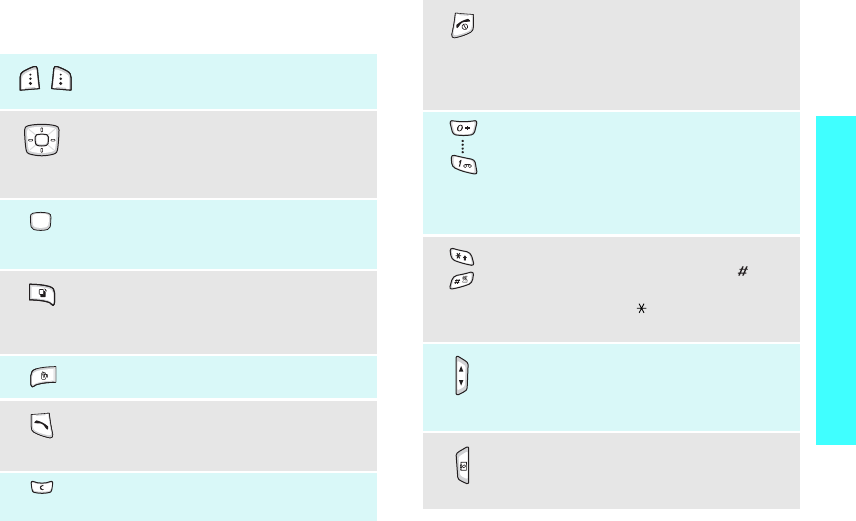
9
Get started
Keys and display
Keys
Perform the function indicated on the
bottom line of the display.
In Idle mode, access your favourite
menu options directly.
p. 76
In Menu mode, scroll through the
menu options.
In Idle mode, access Menu mode.
In Menu mode, select a highlighted
menu option.
Open the application switch window to
open
Call
,
Messages
, and
Vodafone
live!
without exiting the current
application.
Make a video call.
Make or answer a call.
In Idle mode, retrieve numbers
recently dialled, missed, or received.
Delete characters from the display or
an item in an application.
End a call.
Press and hold to switch the phone on
or off.
In Menu mode, cancel input and return
the phone to Idle mode.
Enter numbers, letters, and some
special characters.
In Idle mode, press and hold [
1
] to
access your voicemail server. Press and
hold [
0
] to enter an international call
prefix.
Enter special characters.
In Idle mode, press and hold [ ] to
activate or deactivate the Silent profile.
Press and hold [ ] to enter a pause
between numbers.
Adjust the phone volume.
In Idle mode, adjust the keypad tone
volume. With the phone closed, press
and hold to turn on the backlight.
Press and hold to turn on the camera.
In Camera mode, take a photo or
record a video.
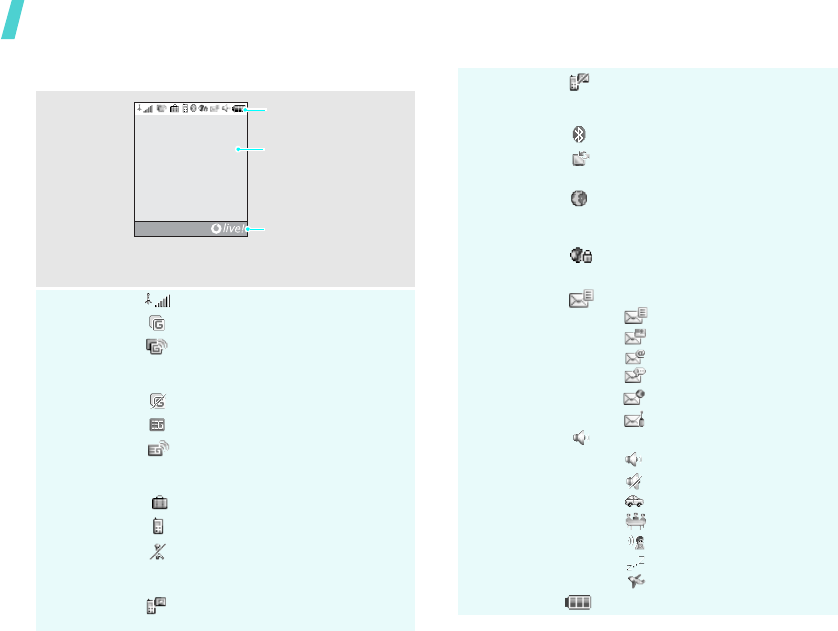
Get started
10
Display
Layout
Icons
*
Received signal strength
2.5G network
Accessing services in a 2.5G
network; when transferring
data, this icon animates
2.5G network unavailable
3G network
Accessing services in a 3G
network; when transferring
data, this icon animates
Active roaming network
Voice call in progress
Out of your service area; you
cannot send or receive voice
calls
Video call in progress
Text and graphics
display messages,
instructions, and
information you enter.
Soft key function
indicators
show the current
functions assigned to
the two soft keys.
Icons
display various icons.
Menu
Out of your service area; you
cannot send or receive video
calls
Bluetooth active
p. 66
Connected with a computer via
a USB port
Browsing the Internet on a
computer using the phone as a
modem
Connected to a secured web
page
New message:
•: SMS
• : MMS
•: E-mail
•: Voicemail
• : Push message
• : Configuration message
Profile setting
p. 76
•: Normal
•: Silent
•: Car
• : Meeting
• : Outdoor
• : Sleeping
• : Flight
Battery power level
* Depending on your country or service provider, the icons
shown on the display may vary.

11
Get started
Access menu functions
Use the soft
keys
The roles of the soft keys vary
depending on the function you are
using. The bottom line of the
display indicates their current
role.
Press the left soft
key to select the
highlighted option.
Press the right soft
key to return to
the previous menu
level.
Select Back
Select an
option
1. Press the appropriate soft
key.
2. Press the Navigation keys to
move to the next or previous
option.
3. Press <
Select
>, <
OK
>, or
[Centre] to confirm the
function displayed or option
highlighted.
4. To exit, choose either of the
following methods:
•Press <
Back
> to move
up one level.
• Press [ ] to return to
Idle mode.
Use shortcuts
Press the number key
corresponding to the option you
want.

Get started
12
Customise your phone
1. In Idle mode, press <
Menu
>
and select
Settings
→
Phone
settings
→
Phone language
→
Screen text
.
2. Select a language.
3. Press <
Options
> and select
Save
.
You can change the call ringer by
changing the properties of the
currently active sound profile.
To change the profile properties:
1. In Idle mode, press <
Menu
>
and select
Settings
→
Phone
settings
→
Phone profiles
.
2. Scroll to the sound profile you
are using.
3. Press <
Options
> and select
Edit
.
4. Select
Voice call ringtone
→
Use my ringtone
→
Sounds & Ringtones
→
a
ringer for voice calls.
5. Select
Video call ringtone
→
Use my ringtone
→
Sounds & Ringtones
→
a
ringer for video calls.
Display
language
Call ringer
melody
6. Press <
Options
> and select
Save
.
To select the sound profile:
1. In Idle mode, press <
Menu
>
and select
Settings
→
Phone
settings
→
Phone profiles
.
2. Select the profile you want.
You can set wallpaper for the idle
screen.
To select a wallpaper image:
1. In Idle mode, press <
Menu
>
and select
My files
→
Pictures
.
2. Select an image.
3. Press <
Options
> and select
Set as
→
Main display
.
4. Press <
Set
>.
To display the selected wallpaper
image:
1. In Idle mode, press <
Menu
>
and select
Settings
→
Display settings
→
Main
display
→
Wallpaper
.
2. Select
Pictures
.
Idle mode
wallpaper

13
Get started
Make/Answer calls
You can quickly activate the
Silent profile to avoid disturbing
other people.
Press and hold [ ] in Idle mode.
You can protect the phone
against unauthorised use with a
phone password. The phone will
require the password on power-
up.
1. In Idle mode, press <
Menu
>
and select
Settings
→
Security
→
Change phone
password
.
2. Enter the default password,
00000000
, and press
<
Confirm
>.
3. Enter a new 4- to 8-digit
password and press
<
Confirm
>.
4. Enter the new password
again and press <
Confirm
>.
5. Select
Phone lock
.
6. Select
Enable
.
7. Enter the password and press
<
Confirm
>.
Silent profile
Phone lock
To make a voice call:
1. Enter an area code and
phone number.
2. Press [ ].
3. To end the call, press [ ].
To make a video call:
1. Enter an area code and
phone number.
2. Press [ ] and if their phone
is compatible, and the other
person appears on the
screen.
1. When the phone is ringing,
press [ ].
2. For a video call, when a
“Allow own picture to be
shown” message appears,
select
Yes
to allow the other
person to see you.
3. To end the call, press [ ].
Press [ / ].
Make a call
Answer a call
Adjust the
volume during
a call
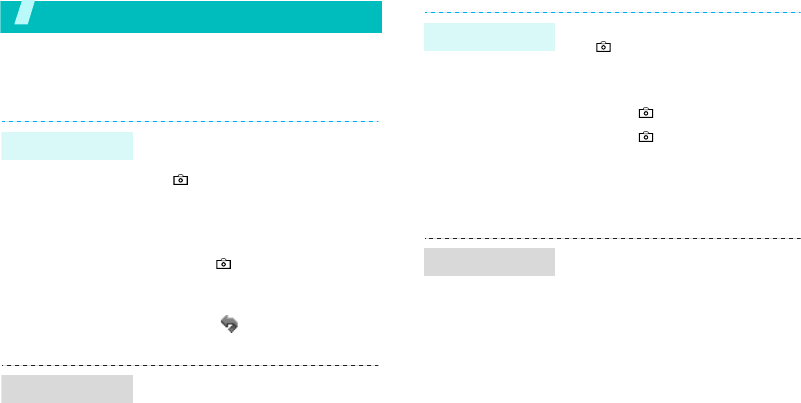
14
Step outside the phone
Begin with your camera, web browser, and other special
features
Use camera
1. Open the phone.
2. In Idle mode, press and hold
[ ] to turn on the camera.
3. Aim the lens at the subject
and make any desired
adjustments.
4. Press [ ] to take a photo.
The photo is saved
automatically.
5. Press < > to take another
photo.
1. In Idle mode, press <
Menu
>
and select
My files
→
Pictures
.
2. Select the photo you want.
Take a photo
View a photo
1. In Idle mode, press and hold
[ ] to turn on the camera.
2. Press [
1
] to switch to Record
mode.
3. Press [ ] to start recording.
4. Press [ ] to stop recording.
The video is saved
automatically.
5. Press <
Back
>
to record
another video.
1. In Idle mode, press <
Menu
>
and select
My files
→
Videos
.
2. Select the video you want.
Record a video
Play a video

15
Step outside the phone
Play music
Use these methods:
• Download from the wireless
web
p. 31
• Download from a computer
using the optional Samsung
PC Studio
Samsung PC
Studio User’s Guide
• Receive via Bluetooth
p. 82
• Copy to a memory card and
insert the card into the
phone.
p. 21
1. In Idle mode, press <
Menu
>
and select
Media player
.
2. Scroll to the
Music
tab.
3. Press <
Options
> and select
Create playlist
.
4. Enter a name for the play list
and press <
Save
>.
5. Select the play list you just
created.
Copy media
files to the
phone
Create a play
list
6. Press <
Options
> and select
Add
→
Playlist
or
Files
.
7. Select a play list, or specific
the files you want and press
<
Add
>.
1. Select the file you want to
play.
2. During playback, use the
following keys:
• Centre: pauses or
resumes playback.
• Up: opens the play list.
• Left: moves back to the
previous file. Moves
backward in a file when
held down.
• Right: skips to the next
file. Skips forward in a file
when held down.
• / : adjusts the volume.
• Down: stops playback.
Play music files

Step outside the phone
16
Browse the web
Using a built-in web browser, you can easily access
the wireless web to get a variety of up-to-date
services and information and to download web
content.
Use Contacts
In Idle mode, press < >.
• To scroll through browser
items, press [Up] or [Down].
•To select an item, press
[Centre] or <
Select
>.
• To return to the previous
page, press <
Back
>.
• To access options, press
<
Options
>.
Launch the
web browser
Navigate the
web browser
To the phone’s memory:
1. In Idle mode, enter a phone
number.
2. Press <
Options
> and select
Add to Contacts
→
Phone
→
New
→
a number type.
3. Specify contact information:
First name, Last name,
Display name, Mobile-private,
Landline-private, Landline-
business, Email, Group, Caller
ID, Ringtone, and Note.
4. Press [Centre] to save the
contact.
To the SIM card:
1. In Idle mode, enter a phone
number.
2. Press <
Options
> and select
Add to Contacts
→
SIM
→
New
.
3. Specify contact information:
Name, Phone number, Group
(for USIM), and Location
number.
4. Press <
Save
> to save the
contact.
Add an entry

17
Step outside the phone
Send messages
1. In Idle mode, press <
Menu
>
and select
Contacts
.
2. Enter the first few letters of
the name you want.
3. Select a contact.
4. Scroll to a number and press
[ ] to dial, or press [Centre]
and select
Edit
to edit contact
information.
1. In Idle mode, press <
Menu
>
and select
Contacts
→
the
Contacts
tab.
2. Press <
Options
> and select
My contact details
.
3. Specify your contact
information.
4. Press [Centre] to save the
name card.
5. To send the name card,
access the name card.
6. Press <
Options
> and select
Send contact details
→
a
sending method.
Find an entry
Create and
send a name
card
1. In Idle mode, press <
Menu
>
and select
Messaging
→
Create message
→
Message
.
2. Enter your message and
press [Centre].
3. Select
Add recipients
→
Contacts
or
Group
→
contacts or a group.
4. Press <
Options
> and select
Send
to send the message.
1. In Idle mode, press <
Menu
>
and select
Messaging
→
Create message
→
Message
.
2. Enter your message.
3. Press <
Options
> to access
the following options:
•
Add content
: add a
media file.
•
Add text
: add the
message text.
Send a text
message (SMS)
Send a
multimedia
message
(MMS)

Step outside the phone
18
•
Add attachment
: add a
name card, schedule item,
or media file.
•
Create item
: create a new
item and add it.
•
Insert
: add a text
template, emoticon,
Contacts entry, or
bookmark.
•
Add subject
: add the
message subject.
4. When you have finished, press
[Centre] and select
Add
recipients
→
Contacts
or
Group
→
contacts or a group.
5. Press <
Options
> and select
Send
to send the message.
Send a
multimedia
message
(MMS)
(continued)
You can send a postcard via the
postal service, if your country
supports it.
1. In Idle mode, press <
Menu
>
and select
Messaging
→
Create message
→
live!
Postcard
.
2. Enter your message.
3. Select the
Picture
line
→
Pictures
→
an image.
4. When you have finished,
select
[Recipient]
→
Contacts
or
New address
.
5. If you select
Contacts
, select
a postal address.
If you select
New address
,
specify the destination
information: Name,
Additional information,
Address, Post Code, City,
County, and Country.
6. When you have finished,
press [Centre] to send the
postcard.
Send a
postcard

19
Step outside the phone
View messages
1. In Idle mode, press <
Menu
>
and select
Messaging
→
Create message
→
Email
.
2. Enter the e-mail text.
3. Press <
Options
> to access
the following options:
•
Add attachment
: add a
name card, schedule
item, or media file.
•
Create item
: create a
new item and add it.
•
Insert
: add a text
template, emoticon,
Contacts entry, or
bookmark.
•
Add subject
: add a
message subject.
4. When you have finished,
press [Centre] and select
Add recipients
→
Contacts
or
Group
→
contacts or a
group.
5. Press <
Options
> and select
Send
to send the e-mail.
Send an e-mail
When a notification appears:
1. Press <
View
>.
2. Select the message from the
Inbox.
From the Inbox:
1. In Idle mode, press <
Menu
>
and select
Messaging
→
Inbox
.
2. Select an SMS message
().
When a notification appears:
1. Press <
View
>.
2. Select the message from the
Inbox.
From the Inbox:
1. In Idle mode, press <
Menu
>
and select
Messaging
→
Inbox
.
2. Select an MMS message
().
View a text
message
View a
multimedia
message

Step outside the phone
20
Use Bluetooth
Your phone is equipped with Bluetooth technology,
enabling you to connect the phone wirelessly to
other Bluetooth devices and exchange data with
them, talk hands-free, or control the phone
remotely.
1. In Idle mode, press <
Menu
>
and select
Messaging
→
Email inbox
.
2. Press <
Options
> and select
Download
.
3. Select an e-mail or a header.
4. If you selected a header,
press <
Options
> and select
Retrieve
to view the body of
the e-mail.
1. In Idle mode, press <
Menu
>
and select
Organiser &
Tools
→
Bluetooth
→
Activation
→
On
.
2. Select
My phone’s visibility
→
On
to allow other devices
to find your phone.
View an e-mail
Turn on
Bluetooth
1. In Idle mode, press <
Menu
>
and select
Organiser &
Tools
→
Bluetooth
→
My
devices
→
Search new
device
.
2. Select a device.
3. Enter a Bluetooth PIN or the
other device’s Bluetooth PIN,
if it has, and press <
OK
>.
When the owner of the other
device enters the same code,
the pairing is complete.
1. Access an application,
Contacts
,
My files
, or
Calendar
,
Tasks
, or
Memo
.
2. Select the item you want to
send.
3. Press <
Options
> and select
Send
contact details
/
Send
→
Via Bluetooth
.
4. Select a device.
5. If necessary, enter the
Bluetooth PIN and press
<
OK
>.
Search for and
pair with a
Bluetooth
device
Send data

21
Step outside the phone
Use a memory card
You can use an optional microSD memory card to
enlarge your phone’s memory capacity.
To receive data via Bluetooth,
your phone’s Bluetooth feature
must be active.
If necessary, press <
Yes
> to
confirm that you are willing to
receive.
• Frequent erasing and writing
will shorten a card’s lifespan.
• Do not remove a card from
the phone or turn off the
phone while data is being
accessed or transferred. This
could result in loss of data
and/or damage to the card or
phone.
• Do not subject cards to strong
shocks.
• Do not touch card terminals
with your fingers or metal
objects. If dirty, wipe the card
with a soft cloth.
Receive data
Important
memory card
information
• Keep cards away from small
children or pets.
• Do not expose cards in a place
subject to electro static
discharge and/or electrical
noise.
Slide a memory card into the
card slot, with the label side face
up.
Using a card adapter and a USB
card reader/writer, you can read
the card on a PC.
1. Insert a memory card into a
card adapter, and then the
adapter into a card reader/
writer.
2. Plug the USB connecter of the
card reader/writer into the
USB port on your PC.
3. Access the appropriate
memory disk and copy to and
from the card.
Insert a
memory card
Use a card
adapter

Step outside the phone
22
Use a memory card
You can use an optional microSD memory card to
increase your phone’s memory capacity.
1. Access an application,
Contacts
,
File manager
,
Calendar
,
Schedule
, or
Task
.
2. Select the item you want to
send.
3. Press <
Options
> and select
Send name card
/
Send
/
Send schedule
/
Send task
→
Via bluetooth
.
4. Select a device.
5. If necessary, enter the
Bluetooth PIN and press
<
OK
>.
1. When a device attempts to
access your phone, press
<
Yes
> to permit the
connection.
2. If necessary, press <
Yes
> to
confirm that you are willing to
receive.
Send data
Receive data
• Frequent erasing and writing
will shorten a card’s lifespan.
• Do not remove a card from
the phone or turn off the
phone while data is being
accessed or transferred. This
could result in loss of data
and/or damage to the card or
phone.
• Do not subject cards to
strong shocks.
• Do not touch card terminals
with your fingers or metal
objects. If dirty, wipe the card
with a soft cloth.
• Keep cards away from small
children or pets.
• Do not expose cards in a
place subject to electro-static
discharge and/or electrical
noise.
Important
memory card
information
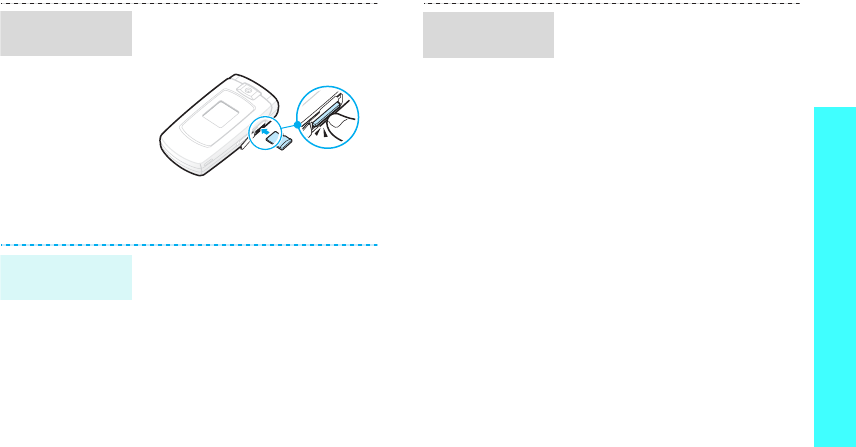
23
Step outside the phone
1. Slide the card into the card
slot, with the label side face
up.
2. Press the card until it locks
into place.
1. Press the card so that it is
disengaged from the phone.
2. Slide the card out of the slot.
Insert a
memory card
Remove the
memory card
Using a card adapter and a USB
card reader/writer, you can read
the card on a PC.
1. Insert a memory card into a
card adapter, and then the
adapter into a card reader/
writer.
2. Plug the USB connecter of the
card reader/writer into the
USB port on your PC.
3. Access the appropriate
memory disk and copy to and
from the card.
Use a card
adapter
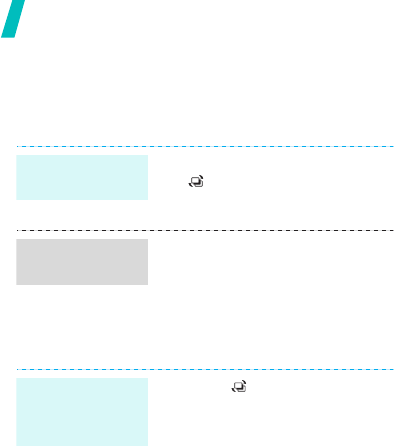
Step outside the phone
24
Switch applications
You can switch to other applications from a menu,
without closing the menu screen you were using.
1. While using a menu, press
[]
.
2. Select an application.
•
Call
: opens the dialling
screen.
•
Messages
: accesses the
Messages
menu.
•
Internet
: launches the web
browser.
1. Press
[]
.
2. Scroll to
End all?
.
3. Press <
Yes
>.
Switch to an
application
Available
applications
Close all
running
applications
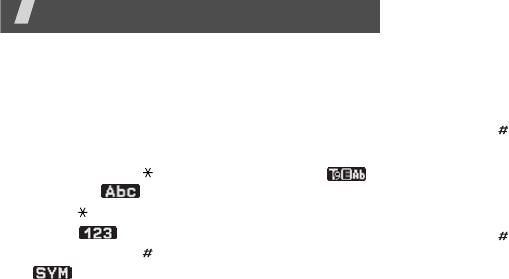
25
Enter text
ABC, T9, Number, and Symbol modes
You can enter text for some features such as
Messages, Contacts, or Organiser, using ABC mode,
T9 mode, Number mode, and Symbol mode.
Changing the text input mode
• Press and hold [ ] to switch between T9 ( )
and ABC ( ) modes.
• Press [ ] to change case or to switch to Number
mode ( ).
• Press and hold [ ] to switch to Symbol mode
().
Using T9 mode
T9 is a predictive text input mode that allows you to
enter any character using single keystrokes.
Entering a word in T9 mode
1. Press [
2
] to [
9
] to start entering a word. Press
each key once for each letter.
For example, press [
4
], [
3
], [
5
], [
5
], and [
6
] to
enter Hello in T9 mode.
T9 predicts the word that you are typing, and it
may change with each key that you press.
2. Enter the whole word before editing or deleting
characters.
3. When the word displays correctly, go to step 4.
Otherwise, press [
0
] to display alternative word
choices for the keys that you have pressed.
For example, Of and Me use [
6
] and [
3
].
4. Press [ ] to insert a space and enter the next
word.
Other T9 mode operations
• Press [
1
] to enter periods or apostrophes
automatically.
• Press [ ] to insert a space.
• Press the Navigation keys to move the cursor.
• Press [
C
] to delete characters one by one. Press
and hold [
C
] to clear the entire display.
Adding a new word to the T9 dictionary
This feature may not be available for some
languages.
1. Enter the word that you want to add.
2. Press [
0
] to display alternative words for your
key presses. When there are no more alternative
words,
Spell
displays on the bottom line.
3. Press <
Spell
>.
4. Enter the word you want using ABC mode and
press <
Add
>.
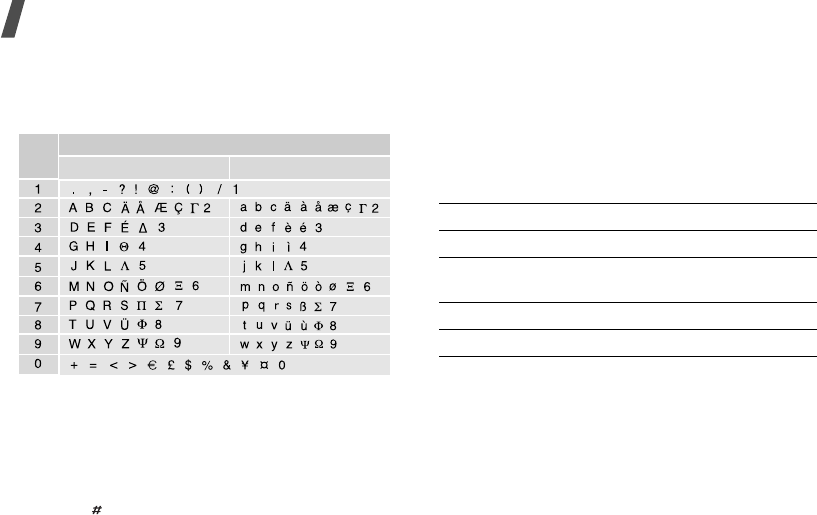
Enter text
26
Using ABC mode
Press the appropriate key until the character you
want appears on the screen.
(Creating an SMS message with GSM alphabet encoding)
Other ABC mode operations
• To enter the same letter twice or to enter a
different letter on the same key, wait for the
cursor to move to the right automatically or
press [Right]. Then, enter the next letter.
• Press [ ] to insert a space.
• Press the Navigation keys to move the cursor.
•Press [
C
] to delete characters one by one. Press
and hold [
C
] to clear the entire display.
Using Number mode
Number mode enables you to enter numbers. Press
the keys corresponding to the digits you want.
Using Symbol mode
Symbol mode enables you to insert symbols.
Upper case Lower case
Key Characters in order
To Press
display more symbols [Up] or [Down].
select a symbol the corresponding
number key.
clear the entered symbols [
C
].
insert the symbols <
OK
>.
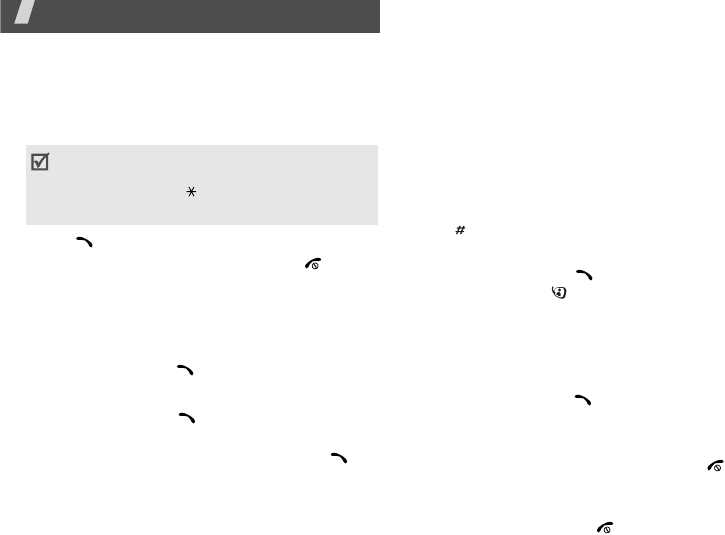
27
Call functions
Advanced calling features
Making a call
1. In Idle mode, enter the area code and phone
number.
2. Press [ ].
3. When you want to end the call, press [
].
Making an international call
1. In Idle mode, press and hold [
0
]. The
+
character appears.
2. Enter the country code, area code, and phone
number, then press [ ].
Redialling recent numbers
1. In Idle mode, press [ ] to display the list of
recent numbers.
2. Scroll to the number you want and press [ ].
Making a call from Contacts
Once you have stored a number in Contacts, you can
dial the number by selecting it from Contacts.
p. 33
You can also use the speed dial feature to assign
your most frequently dialled numbers to specific
number keys.
p. 35
You can quickly dial a number from the USIM/SIM
card using its location number assigned when
stored.
1. In Idle mode, enter a location number and press
[].
2. Scroll through other numbers, if necessary.
3. Press <
Call
> or [ ] to make a voice call, or
<
V-Call
> or [ ] to make a video call.
Answering a call
When you receive an incoming call, the phone rings
and displays the incoming call image.
Press <
Accept
> or [ ] to answer the call.
Tips for answering a call
• When
Anykey
answer
is active, you can press
any key, except for <
Reject
> and [ ]
.
p. 81
• When
Active folder
is active, you can simply
open the phone.
p. 81
• Press <
Reject
> or [ ] to reject a call.
• Press [
C
] to clear the last digit or press and
hold [
C
] to clear the whole display.
• Press and hold [ ] to enter a pause
between numbers.

Call functions
28
• Press and hold [
/
] to reject a call or mute the
ringer, depending on the
Volume key
setting.
p. 81
Viewing missed calls
If you have missed calls, the screen displays how
many calls you have missed.
1. Press <
View
>.
2. If necessary, scroll through the missed calls.
3. Press [ ] to dial the number you want.
Using the headset
Use the headset to make or answer calls without
holding the phone.
Connect the headset to the jack on the left side of
the phone. The button on the headset works as
follows:
Options during a call
You can access a number of functions during a call.
Adjusting the volume during a call
Use [
/
] to adjust the earpiece volume during a
call.
Press [ ] to increase the volume level and press [ ]
to decrease the volume level.
Placing a call on hold/Retrieving
Press <
Hold
> to place a call on hold, or press
<
Unhold
> to retrieve the call.
Making a second call
You can make another call if your network supports
this function.
1. Press <
Hold
> to put the call on hold.
2. Make the second call in the normal way.
3. Press <
Swap
> to switch between the calls.
4. Press <
Options
> and select
Drop
→
Drop
held
call
to end the call on hold.
5. To end the current call, press [ ].
To Press
redial the last call the button twice.
answer a call the button.
end a call and hold the button.

Call functions
29
Answering a second call
You can answer an incoming call while already on
the phone, if your network supports this function
and you have activated the call waiting feature.
p. 83
1. Press [ ] to answer the call. The first call is
automatically put on hold.
2. Press <
Swap
> to switch between the calls.
3. Press <
Options
> and select
Drop
→
Drop
held
call
to end the call on hold.
4. To end the current call, press [ ].
Using the speakerphone feature
Use the phone as a speakerphone to talk and listen
with the phone a short distance away.
Press [
OK
] and then <
Yes
> to activate the
speakerphone feature. Press [
OK
] again to switch
back to the earpiece.
Using In-call options
During a call, press <
Options
> to access the
following options:
•
Loudspeaker
/
Loudspeaker off
: turn on the
speakerphone feature or switch back to Normal
mode.
•
Switch to headset
/
Switch to phone
: switch
the call to a Bluetooth headset or hands-free car
kit, or back to the phone.
•
Join
: set up a multi-party call by adding a caller
on hold to a currently active call. You can include
up to 5 people on a multi-party call.
•
Split
: have a private conversation with one
multi-party call participant. The other
participants can converse with each other. After
the private conversation, select
Join
to return
both private participants to the multi-party call.
•
Drop
: disconnect the call currently on hold or
active call.
•
Drop call
: disconnect one multi-party call
participant.
•
Transfer
: transfer the currently active call to a
caller on hold. The two callers can talk to each
other, but you are disconnected from the call.
•
Mute
/
Unmute
: switch off the phone's
microphone so that the other person on the
phone cannot hear you, or switch it back on.
•
Mute key tone
/
Unmute key tone
: turn the
key tones off or on.
To communicate with answering machines or
computerised telephone systems,
Unmute
key tone
must be selected.

Call functions
30
•
New call
: make a new voice call.
•
Contacts
: locate or store contacts in Contacts.
•
Send text message
: create and send a new
SMS message.
•
Send DTMF
: send DTMF (Dual tone multi-
frequency) tones as a group. The DTMF tones are
the tones used in phones for tone dialling,
sounding when you press the number keys. This
option is helpful for entering a password or an
account number when you call an automated
system, like a banking service.
•
Memo
: create a memo.
•
End call
/
End calls
: disconnect the call currently
on hold, active call, or all calls.
Using the video call feature
In a 3G (UMTS) service area, your phone can make
or receive a video call, allowing you to see another
person on the screen during a conversation. The
other person’s phone must support the video call
feature.
Making a video call
1. In Idle mode, enter the area code and phone
number.
2. Press [ ].
Answering a video call
When you receive a video call, answer a video call as
receiving a voice call. Press <
Show me
> to allow
the caller to see you.
Using video call options
During a video call, press <
Options
> to access the
following options:
•
Loudspeaker
/
Loudspeaker off
: turn on the
speakerphone feature or switch back to Normal
mode.
•
Switch to headset
/
Switch to phone
: switch
the call to a Bluetooth headset or hands-free car
kit, or back to the phone.
•
Mute camera
/
Unmute camera
: turn off or on
the camera.
•
Mute voice
/
Unmute voice
: turn off or on the
microphone.
•
Mute camera & voice
/
Unmute all
: turn off or
on the camera and the microphone.
•
Mute key tone
/
Unmute key tone
: turn off or
on the key tones.
•
Switch camera
: switch between the interior
camera lens and exterior camera lens.
•
Zoom
: display the zoom control bar and zoom in
or out by pressing [Up] or [Down].

31
•
Brightness
/
Hide brightness
: display the
brightness control bar and adjust the brightness
by pressing [Left] or [Right], or hide the control
bar.
•
Effects
: change the colour tone of the image.
•
Hide information
/
Show information
: hide or
display information about the video call.
•
Send DTMF
: send Dual tone multi-frequency
(DTMF) tones as a group after entering the entire
number you need to send or retrieving a number
from Contacts.
•
Video quality
: change the image quality of the
camera.
•
End call
: disconnect the video call.
Menu functions
All menu options listed
Call log
(Menu 1)
Use this menu to view the calls you have dialled,
received, or missed, the length of the calls. You can
also check the cost of your calls, if your USIM/SIM
card supports this function.
To access this menu, press [
OK
] in Idle mode and
select
Call log
.
Missed calls
(Menu 1.1)
This menu displays the most recent calls you did not
answer.
Accessing a call log
1. Press [Left] or [Right] to move to another call
type.
2. Press [Up] or [Down] to scroll through the call
list.
3. Press [
OK
] to view the details of a call, or [ ]
to dial a number.
Using call log options
While viewing call details, press <
Options
> to
access the following options:
•
Voice call
: make a voice call to the number.
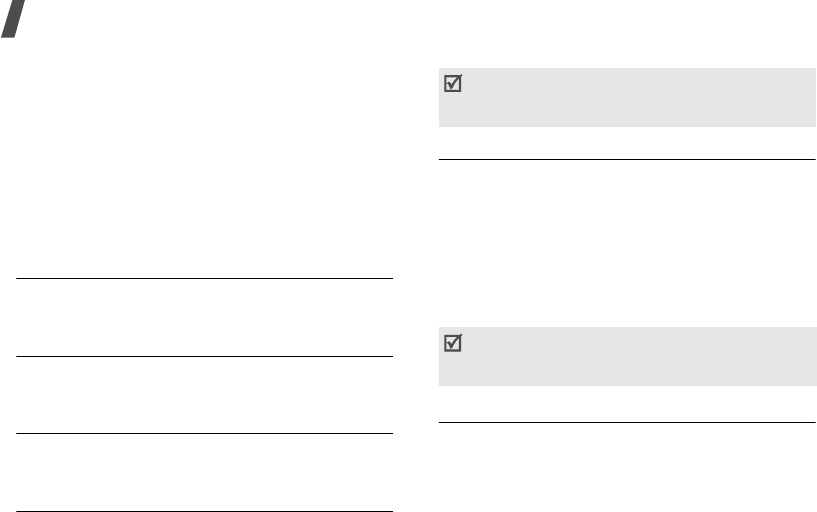
Menu functions
32
•
Video call
: make a video call to the number, if
the 3G service is available.
•
Use number
: paste the selected number to the
normal dialling screen.
•
Save to Contacts
: save the number to
Contacts.
•
Send message
: send a message to the selected
number via SMS, MMS, or File messenger.
•
Delete
: delete the selected call log.
Dialled calls
(Menu 1.2)
This menu displays the most recent calls you have
dialled.
Received calls
(Menu 1.3)
This menu displays the most recent calls you have
received.
Current contacts
(Menu 1.4)
This menu displays all of the calls you have dialled,
received, or missed.
Delete all
(Menu 1.5)
Use this menu to delete all logs in each call type.
1. Press [
OK
] to select the call types to be cleared.
2. Press <
Delete
>.
3. Press <
Yes
> to confirm the deletion.
Data calls
(Menu 1.6)
Use this menu to view the total amount of sent or
received data.
•
Total sent
: check the total amount of data you
have sent.
•
Total received
: check the total amount of data
you have received.
To reset a counter or all counters, press <
Options
>
and select
Reset
or
Reset all
.
Calls cost
(Menu 1.7)
This network feature displays the cost of calls. This
menu is available only if supported by your USIM/
SIM card. Note that this is not intended to be used
for billing purposes.
•
Total costs
:
check the total cost of all your
calls. If the total cost exceeds the maximum cost
set in
Edit cost limit
, you must reset the
counter before you make another call.
•
Last call cost
: check the cost of your last call.
•
Max cost
: check the maximum cost set.
If your phone is locked, it will ask the phone
password. The password is preset to
00000000
.
You can change this password.
p. 87
If the phone is locked, it will require the phone
password. The password is preset to
00000000
.
You can change this password.
p. 87
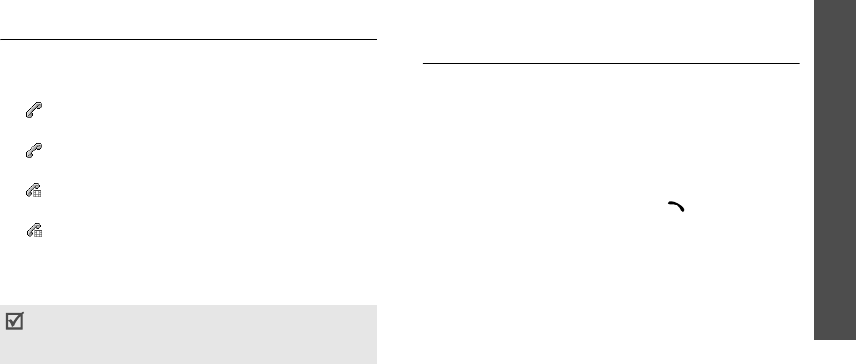
Menu functions
Contacts
(Menu 2)
33
Press <
Options
> to access the following options:
•
Reset call cost
: reset the cost counters.
•
Edit cost limit
: set the maximum cost
authorised for your calls.
•
Setup currency
: set the currency that is
applied when the cost of your call is calculated.
Calls time
(Menu 1.8)
This menu displays the time log for voice and video
calls made and received. The actual time invoiced by
your service provider will vary.
•
Total dialled
: check the total length of voice
calls dialled.
•
Total received
: check the total length of
voice calls received.
•
Total dialled
: check the total length of video
calls dialled.
•
Total received
: check the total length of
video calls received.
To reset a counter or all counters, press <
Options
>
and select
Reset
or
Reset all
.
Contacts
(Menu 2)
You can store phone numbers on your USIM/SIM
card and in your phone’s memory. The USIM/SIM
card and phone’s memory are physically separate,
but they are used as a single entity called Contacts.
To access this menu, press [
OK
] in Idle mode and
select
Contacts
.
Search contact
(Menu 2.1)
Use this menu to search for contact information in
Contacts.
Finding a contact
1. Enter the first few letters of the name that you
want to find.
2. Select the name you want from the list.
3. Scroll to a number and press [ ] to dial, or
press [
OK
] to edit contact information.
Using contact options
While viewing contact details, press <
Options
> to
access the following options:
•
Edit
: edit contact information.
•
Send message
: send a message to the selected
number or e-mail address via SMS, MMS, File
messenger, or e-mail.
•
Special options
: set the following options:
Picture
: assign a caller ID image to alert you to
a call from the person.
If the phone is locked, it will require the phone
password. The password is preset to
00000000
.
You can change this password.
p. 87

Menu functions
34
Ringtone
: assign a ringtone to alert you to a call
from the person.
Msg.
alert tone
: select a ringtone to alert you
to an incoming message from the person.
•
Add to speed dial
: set the selected number as
a speed dial entry.
•
Video call
: make a video call to the number, if
the 3G service is available.
•
Copy to SIM
/
Copy to phone
: copy the contact
from the phone’s memory to the USIM/SIM card,
or vice versa.
•
Send name card
: send the contact via SMS,
MMS, e-mail, File messenger, or Bluetooth.
•
Print via Bluetooth
: print contact information
via a Bluetooth compatible printer.
•
Use number
: paste the selected number to the
normal dialling screen.
•
Delete
: delete the contact.
New contact
(Menu 2.2)
Use this menu to add a new contact to Contacts.
Storing a contact to the phone’s memory
1. Select
Phone
.
2. Change the settings or enter information about
the contact:
•
First name
/
Last name
: assign a name.
•
Phone number
: add a phone number.
•
Work Email
: assign a business e-mail
address.
•
Home Email
: assign a personal e-mail
address.
•
Group
: assign a caller group.
•
Homepage
: enter a homepage address.
•
Birthday
: enter the person’s birthday.
•
More information
: enter the job title,
department, company, nickname, and
additional note of the person.
3. Press <
Options
> and access the following
options to add additional information:
•
Special options
: assign a caller ID image,
call ringer, or message ringer for the contact.
•
Add phone number
: add a phone number
in any type to the contact.
•
Delete phone number
: remove the
selected number type from the contact.
•
Change type
: change the number type from
the contact.
•
Mark video call
/
Unmark video call
: set
the selected number as a video call number,
or cancel the setting.
4. Press <
Options
> and select
Save
to save the
contact.

Menu functions
Contacts
(Menu 2)
35
Storing a contact to the USIM/SIM card
1. Select
SIM
.
2. Enter information about the contact:
•
Name
: assign a name.
•
Phone number
: add a phone number.
•
Group
: (For USIM) assign a caller group.
•
Location number
: enter a location number.
3. If you are using a USIM card, press <
Options
>
to add additional information:
•
Add item
: add a number type to the contact.
•
Delete item
: remove the selected category
from the contact.
4. Press <
Save
>, or press <
Options
> and select
Save
to save the contact.
Groups
(Menu 2.3)
Use this menu to organise your contacts in caller
groups.
Adding members to a caller group
1. Select a group.
2. Press [
OK
] to select the contacts to be added.
3. Press <
Save
>.
Managing caller groups
From the group list, press <
Options
> to access the
following options:
•
View members
: display the members of the
selected group.
•
Add member
: add contacts to the selected
group, if the group does not have any.
•
Add group
: add a new group.
•
Rename group
: change the group name.
•
Delete group
: delete the selected group. Group
members, however, will not be deleted from
Contacts.
•
Delete all groups
: delete all groups including
default groups.
Speed dial
(Menu 2.4)
Use this menu to assign speed dial numbers (2 to 9)
to 8 of your most frequently dialled numbers.
Assigning speed dial numbers
1. Select a key location from
2
to
9
. Key
1
is
reserved for your voicemail server.
2. Select a contact from the contact list.
3. Select a number.
Managing speed dial entries
From the Speed dial screen, press <
Options
> to
access the following options:
•
Add
: assign a number to an unassigned key.
•
Details
: check the name and number assigned
to a key.
•
Video call
: make a video call to the number
assigned to a key.
•
Change
: assign a different number to a key.
•
Remove
: clear the speed dial setting for a key.

Menu functions
36
Dialling speed dial numbers
In Idle mode, press and hold the appropriate key.
My name card
(Menu 2.5)
Use this menu to create your name card and send it
to other people.
Saving your name card
The procedure for creating your name card is the
same as the one for saving a phone number in the
phone’s memory.
p. 34
Using name card options
After saving your name card, press <
Options
> to
access the following options:
•
Edit
: edit the name card.
•
Send name card
: send the name card via SMS,
MMS, e-mail, File messenger, or Bluetooth.
•
Print via Bluetooth
: print your contact
information via a Bluetooth-compatible printer.
Some printers may not be compatible with the
phone.
•
Delete
: delete the name card.
Copy all
(Menu 2.6)
Use this menu to copy all of the contacts stored on
the
USIM/
SIM card to the phone’s memory, or vice
versa.
Own number
(Menu 2.7)
Use this feature to check your phone numbers, or to
assign a name to each of the numbers. Changes
made here do not affect the actual subscriber
numbers on your
USIM/
SIM card.
Service number
(Menu 2.8)
Use this menu to view the list of Service Dialling
Numbers (SDN) assigned by your service provider,
including emergency numbers and numbers for
directory enquiries. This menu is available if your
USIM/SIM card supports SDN.
Scroll to the number you want and press [ ].
Settings
(Menu 2.9)
Use this menu to change the default settings for
Contacts entries.
•
Viewing settings
: change the sort order of the
contact list.
•
Default storage settings
: select a default
memory location for saving contacts. If you
select
Optionally
, the phone will ask you to
select a memory location each time you save a
number.
Memory status
(Menu 2.0)
Use this menu to check the number of contacts you
have stored in the phone’s memory and on the
USIM/SIM card.
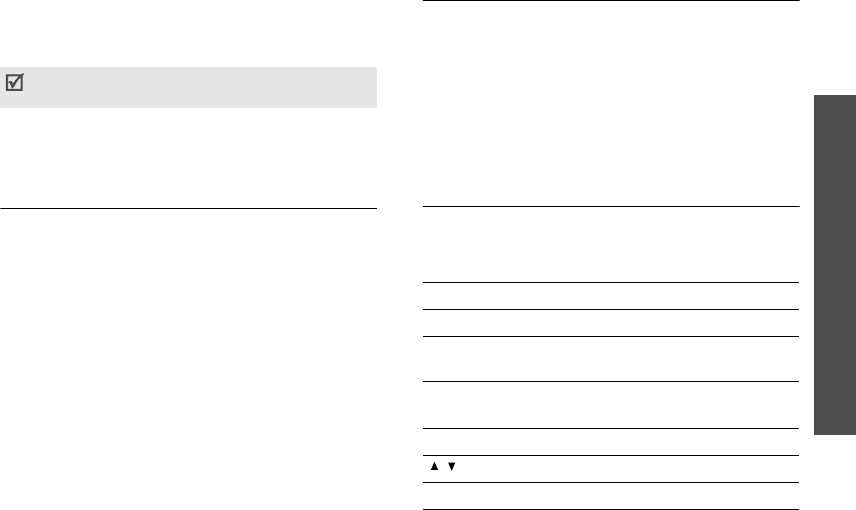
Menu functions
Media player
(Menu 3)
37
Media player
(Menu 3)
You can play music and video files. To enjoy high
quality music, you can use an optional Bluetooth
stereo headset.
To access this menu, press [
OK
] in Idle mode and
select
Media player
.
Downloading or receiving music or video
files
You can play the following types of files on your
phone:
• Music: MP3, AAC, WAV, 3GA, M4A
• Video: MP4, 3GP, RM, RAM, RV
Use the following methods to save music or video
files to your phone’s memory:
• Download from the wireless web
p. 39
• Download from a computer using Samsung PC
Studio
Samsung PC Studio User’s Guide
• Receive via an active Bluetooth connection
p. 72
• Copy to a memory card and insert the card into
the phone
p. 22
Downloaded or received files are stored in the
Downloads
folder in
Music
or
Videos
.
Creating a play list
Add the media files to the play list so you can play
them.
1. From the media player screen, press [
OK
].
2. Press <
Options
> and select
Add
.
3. Select
Folder
or
Files
.
4. Scroll to the folder you want or press [
OK
] to
select the files you want.
5. Press <
Select
> or <
Add
>.
Playing media files
1. From the media player screen, press [
OK
].
2. Select a file. The file plays.
During playback, use the following keys:
Normal headsets and Bluetooth mono headsets
are not compatible with the media player.
Key Function
OK
Pauses or resumes playback.
Left Returns to the previous file. Moves
backward in a file when held down.
Right Skips to the next file. Skips forward in a
file when held down.
Up Accesses the play list.
/
Adjusts the volume.
Down Stops playback.

Menu functions
38
Using media player options
While playing a file, press <
Options
> to access the
following options:
•
Pause
/
Resume
: pause or resume playback.
•
Stop
: stop playback.
•
Transfer to Bluetooth stereo headset
/
Transfer to phone
: switch sound output to a
Bluetooth stereo headset or phone speaker.
•
Send
: send the file via MMS, e-mail, File
messenger, or Bluetooth.
•
Open play list
: access the play list.
•
Activate key
: get a new licence key when the
key for the selected DRM file expires.
•
Reactivate key
: get another licence key even
when the key for the selected DRM file has not
expired.
•
Go to File Manager
: access all music and video
files.
•
Hidden from Bluetooth
/
Visible to Bluetooth
:
hide the file so that other Bluetooth devices
cannot access it, or share the file with other
Bluetooth devices.
•
Show controller
/
Hide controlle
r: display or
hide the control bar of Media player.
•
Details
: access the file properties.
•
Player settings
: change the default settings for
playing media files:
Play options
: select a repeat mode.
Volume
: select a volume level.
Controller
: display or hide the controller image.
Audio player skin
: select a skin image.
•
VOD settings
:
select a connection profile to be
used for accessing a video streaming server. You
can also create or edit a profile.
p. 84
Using play list options
From the media player screen, press [Up]. Press
<
Options
> to access the following options:
•
Play via
: play the selected file via the phone
speaker or a Bluetooth stereo headset.
•
Add
: add files to the play list.
•
Remove
: remove the selected file or all files
from the current play list.
•
Move
: move the selected file to the position you
want within the current play list or another play
list.
•
Copy
: make a copy of the selected file in the
current play list or another play list.
•
New list
: add a new play list.
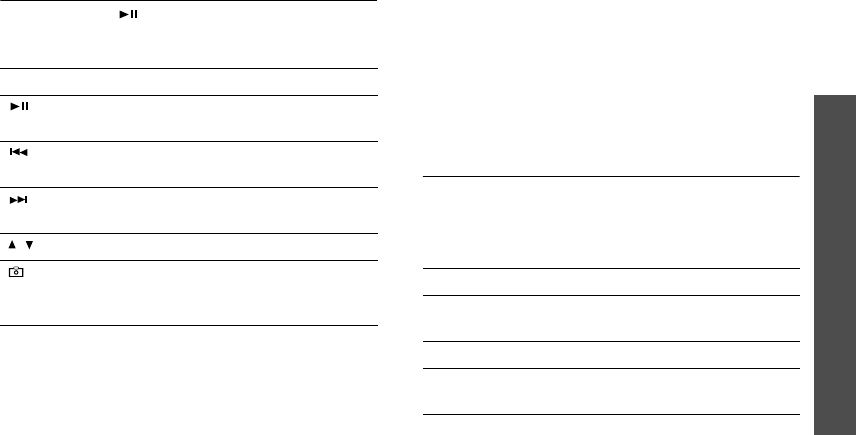
Menu functions
Internet
(Menu 4)
39
Playing music files with the phone closed
Press and hold [ ] to launch the media player and
start playback. Use the following keys to control the
media player:
Internet
(Menu 4)
The web browser on your phone allows you to
access the wireless web. Using the web browser, you
can access up-to-date information and a wide
variety of media contents, such as wallpapers,
ringtones, and music files.
To access this menu, press [
OK
] in Idle mode and
select
Internet
.
Go to homepage
(Menu 4.1)
Use this menu to connect your phone to the network
and load the homepage of the wireless web service
provider.
Navigating the web browser
Using browser options
From any web page, press <
Options
> to access the
following browser options:
•
Go to
: go to the currently linked web page.
Key Function
Pauses or resumes playback. Closes the
media player when held down.
Returns to the previous file. Moves
backward in a file when held down.
Skips to the next file. Skips forward in a
file when held down.
/
Adjusts the volume.
Locks the exposed keys when held down
to keep accidental presses from affecting
playback.
To Press
scroll through browser
items [Up] or [Down].
select a browser item [
OK
] or <
Select
>.
return to the previous
page <
Back
>.

Menu functions
40
•
Go
: move backward or forward through pages in
history.
•
Reload
: reload the current page with updated
information.
•
Desktop view
/
Smart-fit view
: change the
display mode of the browser.
•
Page size
: change the page size.
•
Go to homepage
: return to the homepage.
•
Add to Bookmarks
: bookmark the current
page.
•
View bookmarks
: access the bookmark list.
•
Enter URL
: enter a URL address manually.
•
Copy URL
: send the URL of the current page via
SMS, MMS, or e-mail.
•
Save
: save the image of the current web page or
the current page.
•
Saved pages
: access the list of web pages you
have saved.
•
History
: access the list of web pages you have
accessed.
•
Advanced
: change the various settings for the
browser.
Clear cache
: clear the cache. The cache is a
temporary memory site that stores recently
accessed web pages.
Empty cookies
: delete cookies. Cookies are
pieces of personal information sent to a web
server while navigating the web.
Cookie options
: set whether or not cookies are
stored. If you select
Prompt
, the phone will ask
you to save the cookies of the current page.
Preferences
: change the settings for the web
browser to suit your preference.
Certificates
: access certificate information.
Page details
: access the page properties.
Browser settings
: select a connection profile to
be used for connecting to the Internet. You can
also create or edit a profile.
p. 84
About browser
: access version and copyright
information about the browser.
Exiting the web browser
Press [ ] to end the network connection and exit
the browser.
Enter URL
(Menu 4.2)
Use this menu to manually enter a URL address and
access the associated web page.
You can add the entered URL to the Bookmark list by
selecting
Add bookmark
.

Menu functions
Internet
(Menu 4)
41
Bookmarks
(Menu 4.3)
Use this menu to save URL addresses in order to
quickly access web pages, or access the preset
bookmarks.
Adding a new bookmark
1. Press <
Options
> and select
Add bookmark
.
2. Enter a title and press [Down].
3. Enter a URL address and press <
Save
>.
Using bookmark options
From the bookmark list, press <
Options
> to access
the following options:
•
Go to
: access the bookmarked web page.
•
Enter URL
: enter a URL address manually.
•
Edit bookmark
: edit the URL address and title
of the bookmark, if you selected an added one.
•
Add bookmark
: add a new bookmark.
•
Copy URL
: send the URL address of the
bookmark via SMS, MMS, or e-mail.
•
Delete
: delete the selected bookmark or all
bookmarks, except for the preset ones.
Saved pages
(Menu 4.4)
You can access the list of pages you have saved.
Select a URL from the list to access the
corresponding web page.
From the saved page list, press <
Options
> to
access the following options.
•
View
: access the selected web page.
•
Rename
: change the saved page name.
•
Delete
: delete the selected web page or all
pages.
History
(Menu 4.5)
You can access the list of pages you have accessed.
Select a URL from the list to access the
corresponding web page.
From the history list, press <
Options
> to access
the following options:
•
Go to
: access the selected web page.
•
Delete
: delete the selected web page or all
pages.
•
Details
: access the properties of the web page.
Advanced
(Menu 4.6)
You can access the advanced browser options.
•
Clear cache
: clear the cache. The cache is a
temporary memory site that stores recently
accessed web pages.
•
Empty cookies
: delete cookies. Cookies are
pieces of personal information sent to a web
server while navigating the web.

Menu functions
42
•
Cookie options
: set whether or not cookies are
stored. If you select
Prompt
, the phone will ask
you to save the cookies of the current page.
•
Preferences
: change the settings for the web
browser to suit your preference.
•
About browser
: access version and copyright
information about the browser.
Browser settings
(Menu 4.7)
Use this menu to select a connection profile to be
used for connecting to the Internet. You can also
create or edit a profile.
p. 84
Messages
(Menu 5)
Use the
Messages
menu to send and receive text
messages, multimedia messages, and e-mails. You
can also access push messages, voicemails,
broadcast messages, and configuration messages.
To access this menu, press [
OK
] in Idle mode and
select
Messages
.
Create new
(Menu 5.1)
Use this menu to create and send text messages,
multimedia messages, or e-mails. You can also send
files using MMS.
Text message
(Menu 5.1.1)
Short Message Service (SMS) allows you to send or
receive text messages.
Creating and sending an SMS message
1. Enter your message and press [
OK
].
2. Enter a destination number.
To send the message to more than one recipient,
fill in additional destination fields.
3. Press [
OK
] to send the message.
Using options while composing an SMS
message
While composing a message, press <
Options
> to
access the following options:
•
Send
: send the message.
•
Input method
: change the text input mode.
•
Input language
: change the language to be
used in T9 input mode.
•
Insert
: insert a text template, Contacts entry, or
bookmarked URL address.
•
Save to Drafts
: save the message in the
Drafts
folder.
• The maximum number of characters
allowed in a message varies by service
provider. If your message exceeds the
maximum number of characters, the phone
will split the message.
• You can use various options by pressing
<
Options
>.
next section

Menu functions
Messages
(Menu 5)
43
Multimedia message
(Menu 5.1.2)
Multimedia Message Service (MMS) delivers
messages containing a combination of text, image,
video, and audio, from phone to phone or from
phone to e-mail.
Creating and sending an MMS message
1. Enter the message subject.
2. Select the
Text
line.
3. Enter the message text and press [
OK
].
4. Select the
Picture or Video
or
Audio
line and
add an image, video, or sound clip.
5. When you have finished, press [
OK
].
6. Enter a phone number or e-mail address.
To send the message to more than one recipient,
fill in additional destination fields.
7. Press [
OK
] to send the message.
Using options while composing an MMS
message
While composing a message, press <
Options
> to
access the following options:
•
Input
: enter the message text.
•
Add
: add an image, video, or sound clip.
•
Send
: send the message.
•
Preview
: view the message as it will be shown
on the recipient’s phone.
•
Input method
: change the text input mode.
•
Input language
: change the language to be
used in T9 input mode.
•
Insert text template
: insert a text template.
•
Add contact details
: attach a Contacts entry as
a name card.
•
Add v-calendar
: attach calendar data as a data
format attachment.
•
Save to Drafts
: save the message in the
Drafts
folder.
•
Add page
: add pages. Move to each page by
pressing [Left] or [Right].
•
Move page
: move the current page backward or
forward to change the page order.
•
Delete page
: delete a page.
You can use various options by pressing
<
Options
> in each field.
next section
• The maximum size allowed for a message
can differ, depending on your service
provider.
• Depending on the file type or DRM
(Digital
Rights Management) system,
some files
may not be able to be forwarded.

Menu functions
44
•
Edit style
: change the page properties.
This page
: set the page duration and change
font colour and style for the selected page.
All page
: change the background colour and
page layout.
•
Edit
Text
/
Change file
: edit the added text,
image, video, or sound clip.
•
Delete
text
/
Delete file
: delete the added text,
image, video, or sound clip.
•
Save as template
: save the message as a
template in the
Multimedia templates
folder.
File messenger
(Menu 5.1.3)
Use this menu to send multiple media files by
attaching them to an MMS message.
Creating and sending an MMS message with
files
1. Enter the message subject.
2. Move to the
Message
field.
3. Enter the message text.
4. Move to the
Attach files
line.
5. Press <
Options
> and select
Add files
,
Add
name card
, or
Add v-calendar
.
6. Select images, videos, sounds, name cards, or
calendar data.
7. Press <
Options
> and select
Attach
.
8. When you have finished, press [
OK
].
9. Enter a phone number or e-mail address.
To send the message to more than one recipient,
fill in additional destination fields.
10.Press [
OK
] to send the message.
Using options while composing an MMS
message with files
While composing a message, press <
Options
> to
access the following options:
•
Send
: send the message.
•
Input method
: change the text input mode.
•
Input language
: change the language to be
used in T9 input mode.
•
Insert text template
: insert a text template.
•
Insert
: insert a text template, Contacts entry, or
bookmarked URL address.
•
Attached file list
: access the list of the files you
attached.
•
Add files
: attach images, videos, or sounds.
•
Add name card
: attach a Contacts entry as a
name card.
•
Add v-calendar
: attach calendar data as a data
format attachment.
You can use various options by pressing
<
Options
> in each field.
next section

Menu functions
Messages
(Menu 5)
45
•
Delete all attachments
: delete all
attachments.
•
Save to Drafts
: save the message in the
Drafts
folder.
Email
(Menu 5.1.4)
You can send and receive e-mails that include text,
audio, and images. To use this feature, you need to
subscribe to an e-mail service and set up your
e-mail account.
p. 53
Creating and sending an e-mail
1. Enter the e-mail subject.
2. Move to the
Message
field.
3. Enter the message text.
4. Move to the
Attach files
line.
5. Press <
Options
> and select
Add files
,
Add
name card
, or
Add v-calendar
.
6. Select images, videos, sounds, name cards, or
calendar data.
7. Press <
Options
> and select
Attach
.
8. When you have finished, press [
OK
].
9. Enter an e-mail address.
To send the e-mail to more than one recipient, fill
in additional destination fields.
10.Press [
OK
] to send the e-mail.
Using options while composing an e-mail
While composing an e-mail, press <
Options
> to
access the following options in each field:
•
Send
: send the message.
•
Input method
: change the text input mode.
•
Input language
: change the language to be
used in T9 input mode.
•
Insert text template
: insert a text template.
•
Insert
: insert a text template, Contacts entry, or
bookmarked URL address.
•
Attached file list
: access the file list you
attached.
•
Add files
: add images, videos, or sounds.
•
Add name card
: attach a Contacts entry as a
name card.
•
Add v-calendar
: attach calendar data as a data
format attachment.
•
Delete all attachments
: delete all
attachments.
•
Save to Drafts
: save the e-mail in the
Drafts
folder.
You can use various options by pressing
<
Options
> in each field.
next section
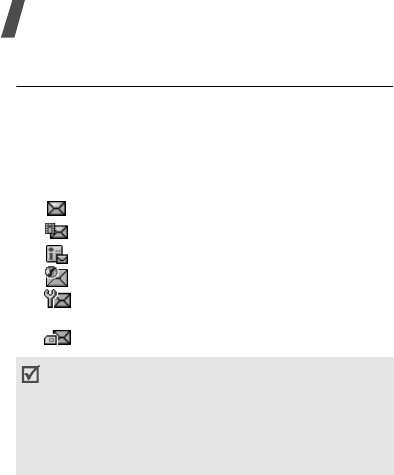
Menu functions
46
Inbox
(Menu 5.2)
This folder stores all types of messages you have
received, except for e-mails.
Viewing a message
The following icons may appear on the list to show
the message type:
• SMS message
• MMS message
• MMS notification
• Push message from web servers
• Configuration message, containing network
parameters from your service provider
• USIM/SIM
Using message options
While viewing a message, press <
Options
> to
access the following options:
SMS messages
•
Call
/
Go to URL
/
Go to RTSP
: dial the
highlighted phone number or access the
highlighted web link.
•
Add to bookmark
: save the highlighted web
link to the bookmark list.
•
Create email
: send an e-mail to the highlighted
e-mail address.
•
Create multimedia message
: send an MMS
message to the highlighted phone number or
e-mail address.
•
Reply
: reply to the sender via SMS, MMS, or File
messenger.
•
Forward
: forward the message to other people.
•
Call back
: dial the phone number of the sender.
•
Save to Contacts
: save the sender’s phone
number to Contacts. If a phone number, e-mail
address, or URL address within the message is
selected, you can also save it to Contacts.
•
Move to SIM
/
Move to phone
: move the
message between the phone’s memory and the
USIM/SIM card.
•
Print via Bluetooth
: print the message via a
Bluetooth-compatible printer. Some printers may
not be compatible with the phone.
•
Delete
: delete the message.
MMS messages
•
Call
/
Go to URL
/
Go to RTSP
: dial the
highlighted phone number or access the
highlighted web link.
•
Add to bookmark
: save the highlighted web
link to the bookmark list.
• Depending on the DRM (Digital Rights
Management) system, messages having web
content may not be able to be forwarded.
• A
!
icon next to a message means that the
message is of high priority. A grey-coloured
message icon indicates low priority.

Menu functions
Messages
(Menu 5)
47
•
Create email
: send an e-mail to the highlighted
e-mail address.
•
Create multimedia message
: send an MMS
message to the highlighted phone number or
e-mail address.
•
Play
:
play the message.
•
Reply
: reply to the sender via SMS, MMS, or File
messenger.
•
Reply to all
: send a reply to the sender and all
recipients.
•
Forward
: forward the message to other people.
•
Call back
: dial the phone number of the sender.
•
Save as template
: save the message as a
template in the
Multimedia templates
folder.
•
Save files
: save media items from the message
into your phone’s memory or a memory card.
•
Save to Contacts
: save the sender’s phone
number to Contacts. If a phone number, e-mail
address, or URL address within the message is
selected, you can also save it to Contacts.
•
Print via Bluetooth
: print the message via a
Bluetooth-compatible printer. Some printers may
not be compatible with the phone.
•
Delete
: delete the message.
•
Details
: access the message properties.
Push messages
•
Go to URL
/
Go to RTSP
: connect to the URL
specified in the message.
•
Delete
: delete the message.
Configuration messages
•
Install
: apply the configuration value in the
message to your phone.
•
Delete
: delete the message.
Delivery reports
•
Call back
: dial the phone number of the sender.
•
Save to Contacts
: save the sender’s phone
number to Contacts. If a phone number, e-mail
address, or URL address within the message is
selected, you can also save it to Contacts.
•
Delete
: delete the report.
Drafts
(Menu 5.3)
This folder stores messages you have saved to send
them at a later time.
From the message list, press <
Options
> to access
the following options:
•
View
: open the selected message.
•
Edit
: edit the selected message.
•
Send
: send the message.
•
Sort by
: change the sort order of the message
list.
•
Delete
: delete the selected message.
•
Delete all
: delete all messages.
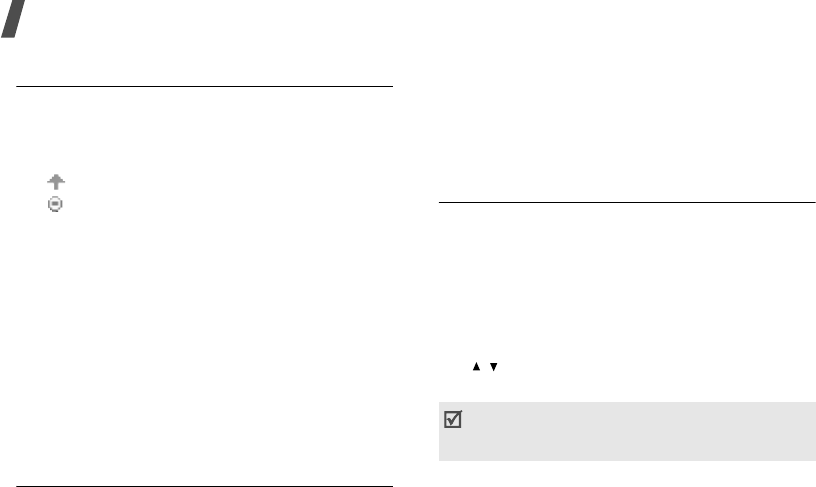
Menu functions
48
Outbox
(Menu 5.4)
This folder stores messages that the phone is
attempting to send or has failed to send.
The following icons on the message list indicates the
sending status:
• Being sent
• Failed to be sent
From the message list, press <
Options
> to access
the following options:
•
View
: open the selected message.
•
Send again
: resend the message.
•
Edit
: edit the message.
•
Cancel sending
: cancel sending the message.
•
Sort by
: change the sort order of the message
list.
•
Delete
: delete the selected message.
•
Delete all
: delete all messages.
•
Details
: access the message properties.
Sent box
(Menu 5.5)
This folder stores messages that you have sent.
From the message list, press <
Options
> to access
the following options:
•
View
: open the selected message.
•
Forward
: forward the message to other people.
•
Sort by
: change the sort order of the message
list.
•
Delete
: delete the selected message.
•
Delete all
: delete all messages.
•
Details
: access the message properties.
Email inbox
(Menu 5.6)
This folder stores e-mails that you have received.
Viewing received e-mails
1. Press <
Options
> and select
Download
.
The phone checks the e-mail server and
downloads new e-mails.
2. Select an e-mail or a header.
3. If the e-mail has more than one page, press
[
/
] to scroll through pages one by one.
4. Select an attached file to view or play it.
Using e-mail options
While viewing the e-mail or header, press
<
Options
> to access the following options:
•
View
: open the selected e-mail.
•
Retrieve
: retrieve the body of the selected
e-mail header from the e-mail server.
•
Reply
: send a reply to the sender.
Depending on the DRM
(Digital Rights
Management) system, messages having web
content may not be able to be forwarded.
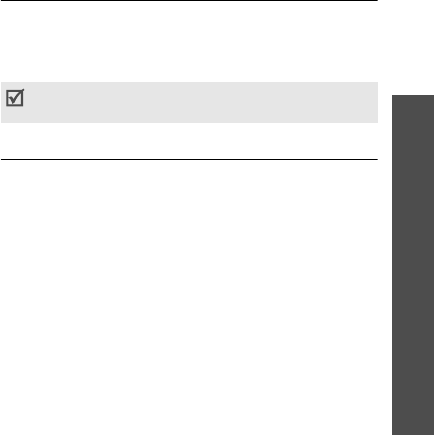
Menu functions
Messages
(Menu 5)
49
•
Reply to all
: send a reply to the sender and all
recipients.
•
Forward
: forward the e-mail to other people.
•
Download
: download new e-mails or headers
from the e-mail server.
•
Sort by
: change the sort order of the e-mail list.
•
Save files
: save the selected file.
•
Save to Contacts
: extract phone numbers or
e-mail addresses from the e-mail and save them
in Contacts.
•
Block
:
add the sender’s e-mail address or e-mail
subject to the Block list to reject e-mails from
that address or containing that subject.
•
Delete from phone
: delete the selected e-mail
or all e-mails from the phone’s memory.
•
Delete permanently
: delete the selected
e-mail or all e-mails from both the phone’s
memory and the e-mail server.
•
Email accounts
: change the active e-mail
account.
•
Print via Bluetooth
: print the e-mail via a
Bluetooth-compatible printer. Some printers may
not be compatible with the phone.
•
Details
: access the e-mail properties.
Media Album
(Menu 5.7)
Use this menu to access the Media Album service,
with which you can organise your own online media
album, adding media content and messages via the
wireless web.
Templates
(Menu 5.8)
Use this menu to create, edit, and send SMS
templates and MMS templates.
Text templates
(Menu 5.8.1)
You can create SMS templates with the sentences
you use frequently so that you can retrieve and
insert them when composing an SMS message.
Creating a template
1. Press <
New
>, or press <
Options
> and select
New
, if one has been already stored.
2. Enter a message and press [
OK
].
Using template options
From the template list, press <
Options
> to access
the following options:
•
Send
:
create and send a new message using the
template via SMS, MMS, File messenger, or
e-mail.
•
New
: add a new template.
•
Edit
: change the selected template.
This feature may not be available, depending on
your country.

Menu functions
50
•
Delete
: delete the selected template.
•
Delete all
: delete all templates.
Multimedia templates
(Menu 5.8.2)
You can create MMS templates so that you can use
them in composing an MMS message.
Creating a template
1. Press <
New
>, or press <
Options
> and select
New
, if one has been already stored.
2. Create a template as you would when creating
an MMS message.
3. Press <
Options
> and select
Save as template
to save the template.
Using template options
From the template list, press <
Options
> to access
the following options:
•
View
: open the selected template.
•
Send
:
send the selected template via MMS.
•
New
: add a new template.
•
Edit
: edit the selected template.
•
Delete
: delete the selected template.
•
Delete all
: delete all templates.
Broadcast
(Menu 5.9)
Your phone receives broadcast messages, which are
text messages related to various topics, such as
weather forecast, traffic, and news report, from
networks. Use this menu to access received
broadcast messages.
Viewing a broadcast message
All broadcast messages are stored in the
Temporary
folder and will be deleted after a period
of time. If you do not want a message to be deleted,
save it to the
Archive
folder. While viewing the
message, press <
Options
> and select
Save
.
Using message options
While viewing a message, press <
Options
> to
access the following options:
•
Call
/
Go to URL
/
Go to RTSP
: dial the
highlighted phone number or access the
highlighted web link.
•
Create email
: send an e-mail to the highlighted
e-mail address.
•
Save
: save the message in the
Archive
folder.
•
Delete
: delete the message.
Delete all
(Menu 5.0)
Use this menu to delete messages in each message
type at once.
1. Press [
OK
] to select the message types to be
cleared.
2. Press <
Delete
>.
3. Press <
Yes
> to confirm the deletion.

Menu functions
Messages
(Menu 5)
51
Settings
(Menu 5.*)
Use this menu to set up various options for using
messaging services.
Text message
(Menu 5.*.1)
You can configure SMS settings.
•
Settings x
: set the properties of each profile:
Centre address
: store or change the number of
your SMS server.
Expiration
: set the length of time your
messages are stored in the SMS server.
Default type
: set the default message type. The
network can convert messages into the selected
format.
Name
: enter a profile name.
•
Sending settings
: set up the options for
sending SMS messages:
Reply path
: allow recipients to reply to you
through your SMS server.
Delivery report
: set the network to inform you
when your messages are delivered.
Network selection
: select
CS preferred
(GSM) or
PS preferred
(GPRS), depending on
your network.
Keep a copy
: leave copies of your messages in
the
Sent box
folder after sending.
Character support
: select a character encoding
type. When you select
Automatic
, the phone
switches the encoding type from GSM alphabet
to Unicode if you enter an Unicode character. Use
of Unicode encoding will reduce the maximum
number of characters in a message to about half.
If this menu is not shown, your phone provides
the automatic character encoding by default.
Multimedia message
(Menu 5.*.2)
You can configure MMS settings.
•
Sending options
: set up the options for sending
MMS messages:
Priority
: set the priority level of messages.
Expiration
: set the length of time messages are
stored in the MMS server.
Custom time(Hour)
: enter the length of time
you want if you select
Custom time
in the
Expiration
option.
Delivery
: set a time delay before messages are
sent.
Custom time(Hour)
: enter the length of time
you want if you select
Custom time
in the
Delivery
option.
Hide address
: set your address to be hidden
from the recipient’s phone.
Request delivery report
: set the network to
inform you when your messages have been
delivered.

Menu functions
52
Request read report
: send a read-replay
request along with your messages.
Keep a copy
: leave copies of your messages in
the
Sent box
folder after sending.
Add my name card
: allow your contact
information to be attached to your messages via
File messenger.
Add signature
: allow your signature to be
attached to your message via File messenger.
Input signature
: enter your signature.
•
Receiving options
: set up the options for
receiving MMS messages:
Home network
: determine if your phone
retrieves new messages automatically when you
are in your home service area.
Roaming network
: determine if your phone
retrieves new messages automatically when you
are roaming in another network.
Reception within your home network or while
roaming has the following options:
-
Auto download
: the phone automatically
retrieves messages from the server.
-
Manual
: the phone receives notifications first
from the server. Use the
Retrieve
option to
manually retrieve new messages.
-
Restricted
: the phone receives notifications
first from the server. When you attempt to
retrieve new messages, the phone informs you
of additional charges.
-
Reject
: the phone rejects all messages.
Send delivery report
: set the network to
inform the sender when a message has been
delivered to you.
Send read report
: determine whether or not
the phone sends a read-reply when an incoming
message has been read.
Reject anonymous
: reject messages from
unknown senders.
Reject advertisement
: reject advertisements.
•
MMS profiles
: select a connection profile to be
used for MMS. You can also create or edit a
profile.
p. 84
•
Message size
: select a maximum file size of
allowed for messages. Available message size
may vary, depending on your country.
•
Creation mode
: select an MMS creation mode:
Warning
: you can create a message with any
type of content and of any size, but the phone
will inform you when the content and size exceed
the maximum.
Free
: you can create a message with any type of
content and of any size.
Restricted
: you can create a message with any
type of contents and size.
•
Slide interval
: select the length of time the
display shows each page in a message.

Menu functions
Messages
(Menu 5)
53
Email
(Menu 5.*.3)
You can configure e-mail settings.
•
Sending options
: set up the options for sending
e-mails:
From
: set the sender name.
Sending account
: select the default account.
Priority
: select the priority level of e-mails.
Keep a copy
: leave copies of your e-mails in the
Sent box
folder after sending.
Include body when replying
: set whether or
not the phone includes the original e-mail text in
a reply.
Delivery report
: set the network to inform you
when your e-mails are delivered.
Add my name card
: allow your contact
information to be attached to e-mails.
Add signature
: attach your signature to
e-mails.
Input signature
: enter your signature.
•
Receiving options
: set up the options for
receiving e-mails:
Set download limit
: determine the maximum
size for incoming e-mails. Your phone will reject
e-mails that exceed the specified size.
Auto polling
: set the phone to automatically
check the e-mail server to download e-mails at
the specified intervals.
Polling frequency
: set how often the phone
checks the e-mail server for automatic polling.
Block address
: specify e-mail addresses to
reject e-mails from those addresses, and
activate or deactivate mail blocking.
Block subject
: specify subjects to reject e-mails
which contain those subjects you specify, and
activate or deactivate mail blocking.
•
Email profiles
: select a network connection
profile to be used for e-mail services. You can
also create or edit a profile.
p. 84
•
Email accounts
: set up an e-mail account and
select an account to be used. Press <
Options
>
and select
Edit
to access the following options
for setting up an account:
Account name
: enter a name for the currently
selected account.
SMTP server
: enter the IP address or host
name of the outgoing e-mail server.
SMTP port
: enter the SMTP port number.
Use SSL
: activate the use of the SSL (Secure
Sockets Layer) protocol.
Retrieving server type
: select the protocol for
the incoming e-mail server. The remaining
options depend on the protocol type setting.
You cannot change e-mail profile settings while an
e-mail is being sent or retrieved.

Menu functions
54
POP3 server
/
IMAP4 server
: enter the IP
address or host name of the POP3 or IMAP4
server.
POP3 port
/
IMAP4 port
: enter the POP3 or
IMAP4 port number.
Use SSL
: activate the use of the SSL (Secure
Sockets Layer) protocol.
IMAP4 retrieving option
: (IMAP4 protocol
only): set whether the phone retrieves only new
messages or all messages.
Retrieving option
: set wether the phone
downloads e-mail headers only or the complete
e-mail.
Keep in server
: leave the copies of e-mails on
the e-mail server after retrieving.
My Address
: set your e-mail address.
User name
: enter the POP3 or IMAP4 user
name.
Password
: enter the POP3 or IMAP4 password.
Use SMTP Authentication
: enable SMTP
authentication, which requires the user to log in
before sending e-mails.
Same as POP3/IMAP4
: select if you want the
SMTP server to have the same parameters as the
POP3 or IMAP4 server.
User name
: enter the SMTP user name.
Password
: enter the SMTP password.
Voice mail
(Menu 5.*.4)
Use this menu to set the number of your voicemail
server.
Push message
(Menu 5.*.5)
You can change the settings for receiving push
messages from the wireless web server.
•
Receiving option
: set whether or not to receive
push messages from the web server.
•
Service loading
: whether or not your phone
automatically launches the web browser as a
push message comes in.
Broadcast
(Menu 5.*.6)
You can change the settings for receiving broadcast
messages.
•
Receive
: select whether or not the phone
receives broadcast messages.
•
Channel
: indicate the channels from which you
wish to receive broadcast messages. Please
contact your service provider for further details.
•
Language
: select the preferred languages in
which broadcast messages display.
You must store the voicemail server number
before accessing the server. Your service provider
can give you the number.

Menu functions
File manager
(Menu 6)
55
Memory status
(Menu 5.#)
Use this menu to view the number of messages or
the amount of memory currently in use for each
message type in each folder.
File manager
(Menu 6)
The
File manager
menu allows you to access
images, videos, music files, and sounds stored in the
phone’s memory or on a memory card.
To access this menu, press [
OK
] in Idle mode and
select
File manager
.
Tips for Digital Rights Management
As a result of the Digital Rights Management (DRM)
system, some of the media items you download
from the Internet or receive by MMS may require a
licence key to access them. You can acquire the key
from the website which owns the rights to the
content; use the
Activate key
option.
Note the following icons on the list:
• : Forwardable item with a valid key.
• : Forwardable item without a valid key.
• : Unforwardable item with a valid key.
• : Unforwardable item without a valid key.
Your phone supports only count-based or unlimited-
access DRM files.
Images
Use this menu to access photos you have taken and
images you have downloaded, received in
messages, or imported from your computer.
Viewing an image
1. Scroll to an image folder.
2. Select an image.
Viewing a slide show
You can view your images as a slide show, a
sequential presentation of each image in the current
folder.
1. While viewing an image, press <
Options
> and
select
Slide show
.
The slide show begins.
2. Press <
Back
> to stop the slide show.
Editing an image
1. While viewing an image, press <
Options
> and
select
Edit
.
2. Press <
Options
> and edit the photo using the
following options:
•
Save as
: save the file as a different name.
•
Resize
: change the image size.
•
Effects
: change the colour tone or apply a
special effect to the photo.
•
Adjust
: adjust the brightness, contrast, or
colour balance.

Menu functions
56
•
Frames
: apply a decorative frame.
•
Cliparts
: add an image clip to the photo.
•
Insert text
: add text to the photo.
•
Rotate
: rotate the photo clockwise or
counterclockwise.
•
Flip
: flip the photo vertically or horizontally.
•
Crop
: select a variously sized and shaped
section of the photo.
3. When you have finished, press <
Done
>.
4. Press [
OK
]
.
5. Enter a photo name and press <
Save
>.
Using image options
While viewing a file, press <
Options
> to access the
following options:
•
Send
: send the file via MMS, e-mail, File
messenger, or Bluetooth.
•
Print via
: print the image by connecting the
phone to a printer via USB or Bluetooth. Some
printers may not be compatible with the phone.
•
Hidden from Bluetooth
/
Visible to Bluetooth
:
hide the file so that other Bluetooth devices
cannot access it, or share the file with other
Bluetooth devices.
•
Set as
: set the image as your wallpaper for the
displays or a caller ID image for a Contacts
entry.
•
Move
: move the file to another folder.
•
Copy
: copy the file to another folder.
•
Real size
: view the image in its actual size.
Press <
Phone size
> to fit the image to the
display.
•
Slide show
: view all images as a slide show.
•
Activate key
: get a new licence key when the
key for the selected DRM file expires.
•
Reactivate key
: get another licence key even
when the key for the selected DRM file has not
expired.
•
Edit
: edit the image and save it as a different
file.
•
Delete
: delete the file.
•
Rename
: change the file name.
•
Details
: access the file properties.
•
Key management
: manage licence keys you
have acquired.
Downloading images
1. Scroll to the
Downloads
folder.
2. Select
More pictures
. You are connected to the
website preset by your service provider.
3. Search for the file you want and follow the
onscreen instructions to download it.

Menu functions
File manager
(Menu 6)
57
Videos
Use this menu to access video clips you have
recorded, downloaded, received in messages, or
imported from your computer.
Playing a video clip
1. Scroll to a video folder.
2. Select a video clip. The media player opens.
p. 37
Using video options
From the video list, press <
Options
> to access the
following options:
•
Play
: play the video clip.
•
Add to play list
: add the file to the play list.
•
Send
: send the file via MMS, e-mail, File
messenger, or Bluetooth.
•
Hidden from Bluetooth
/
Visible to Bluetooth
:
hide the file so that other Bluetooth devices
cannot access it, or share the file with other
Bluetooth devices.
•
Activate key
: get a new licence key when the
key for the selected DRM file expires.
•
Reactivate key
: get another licence key even
when the key for the selected DRM file has not
expired.
•
Move
: move the file to another folder.
•
Copy
: copy the file to another folder.
•
Delete
: delete the selected file or all files.
•
Rename
: change the file name.
•
Lock
/
Unlock
: lock the file to prevent it from
being deleted, or unlock the file.
•
New folder
: add a new folder.
•
Details
: access the file properties.
•
Memory status
: access the memory
information for each folder in
File manager
.
•
Key management
: manage licence keys you
have acquired.
Downloading video clips
1. Scroll to the
Downloads
folder.
2. Select
More videos
. You are connected to the
website preset by your service provider.
3. Search for the file you want and follow the
onscreen instructions to download it.
Music
This menu displays music files you have downloaded
or received in messages.
Playing a music file
Select a music file. The media player opens.
p. 37
Video clips recorded on other devices, such as
camcorders, may not play correctly.

Menu functions
58
Using music options
From the music list, press <
Options
> to access the
following options:
•
Play
: play the music file.
•
Add to play list
: add the file to the play list.
•
Send
: send the file via MMS, e-mail, File
messenger, or Bluetooth.
•
Hidden from Bluetooth
/
Visible to Bluetooth
:
hide the file so that other Bluetooth devices
cannot access it, or share the file with other
Bluetooth devices.
•
Set as ringtone
: set the music file as your
ringtone for voice calls or video calls.
•
Set as caller ID
: set the music file as a ringtone
for a Contacts entry.
•
Activate key
: get a new licence key when the
key for the selected DRM file expires.
•
Reactivate key
: get another licence key even
when the key for the selected DRM file has not
expired.
•
Delete
: delete the selected file or all files.
•
Rename
: change the file name.
•
Lock
/
Unlock
: lock the file to prevent it from
being deleted, or unlock the file.
•
New folder
: add a new folder.
•
Details
: access the file properties.
•
Memory status
: access the memory
information for each folder in
File manager
.
•
Key management
: manage licence keys you
have acquired.
Downloading music files
1. Select
More music
. You are connected to the
website preset by your service provider.
2. Search for the file you want and follow the
onscreen instructions to download it.
Sounds
Use this menu to access voice memos you have
recorded, and sound clips you have downloaded,
received in messages, or imported from your
computer.
Playing a sound clip
1. Scroll to a sound folder.
2. Select a sound clip. The selected sound plays.
For a voice memo, see
Voice recorder
.
p. 75
During playback, use the following keys:
Key Function
Left Returns to the previous file.
Right Skips to the next file.
Up/Down/
/
Adjusts the volume.

Menu functions
File manager
(Menu 6)
59
Using sound options
From the sound list, press <
Options
> to access the
following options:
•
Play
: play the selected file.
•
Send
: send the file via MMS, e-mail, File
messenger, or Bluetooth.
•
Hidden from Bluetooth
/
Visible to Bluetooth
:
hide the file so that other Bluetooth devices
cannot access it, or share the file with other
Bluetooth devices.
•
Set as ringtone
: set the sound clip as your
ringtone for voice calls or video calls.
•
Set as caller ID
: set the sound clip as a
ringtone for a Contacts entry.
•
Activate key
: get a new licence key when the
key for the selected DRM file expires.
•
Reactivate key
: get another licence key even
when the key for the selected DRM file has not
expired.
•
Move
: move the file to another folder.
•
Copy
: copy the file to another folder.
•
Delete
: delete the selected file or all files.
•
Rename
: change the file name.
•
Lock
/
Unlock
: lock the file to prevent it from
being deleted, or unlock the file.
•
New folder
: add a new folder.
•
Details
: access the file properties.
•
Memory status
: access memory information for
each folder in
File manager
.
•
Key management
: manage licence keys you
have acquired.
Downloading sound clips
1. Select
More ringtones
. You are connected to
the preset website by your service provider.
2. Search for the file you want and follow the
onscreen instructions to download it.
Games & More
Use this menu to access the embedded Java games
and download Java applications.
Accessing a game
Select a game from the game list and follow the
onscreen instructions. The procedure may differ
from game to game.
Using Java game options
From the application list, press <
Options
> to
access the following options:
•
Download
: connect to the preset website and
download games.
OK
Allows you to send the selected file to
other people.
Key Function
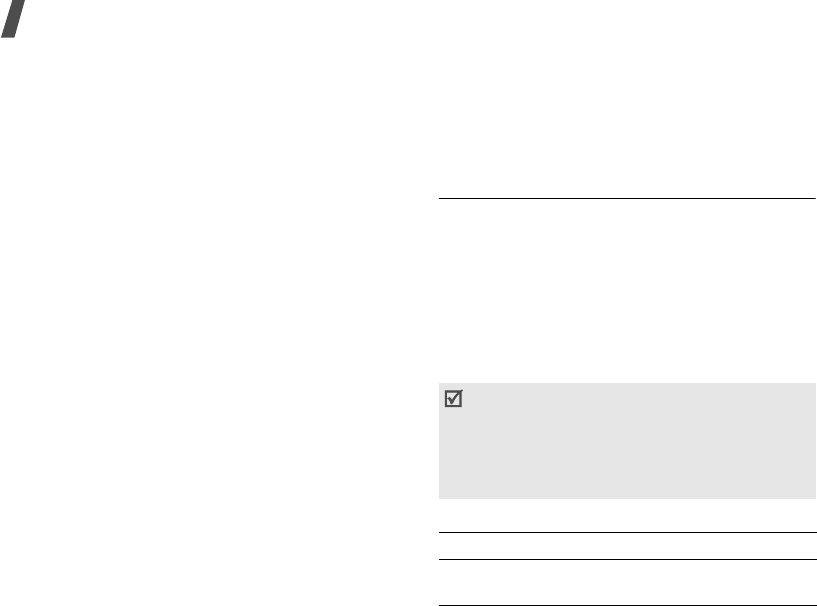
Menu functions
60
•
Play
: launch the selected application.
•
Activate key
: get a new licence key when the
key for the selected DRM file expires.
•
Reactive key
: get another licence key even
when the key for the selected DRM file has not
expired.
•
Move
: move the game to another folder.
•
Delete
: delete the selected application or game
folder, except for embedded games and default
game folders.
•
Rename
: change the name of the game or
game folder.
•
Lock
/
Unlock
: lock the application to prevent it
from being deleted, moved, and renamed, or
unlock the application.
•
Details
: access the application properties.
•
Key management
: manage licence keys you
have acquired.
•
New folder
: add a new folder.
•
Network settings
: select a connection profile
to be used for applications requiring network
access. You can also create or edit a profile.
p. 84
•
Memory status
: access memory information for
each folder in
File manager
.
Downloading new games
1. Select
More games
. You are connected to the
website preset by your service provider.
2. Search for the application you want and follow
the onscreen instructions to download it.
Other files
Use this menu to access any other files than image,
video, music and sound files. Your phone provides
you with Picsel File Viewer to allow you to view,
without corruption, various document files. Available
file formats are *.doc, *. xls, *.ppt, *.pdf, *.html,
and *.txt.
Viewing a document
Select a file. Picsel File Viewer runs and open the
document.
Use the following keys to view the document:
• Depending on the file size or memory capacity
of Picsel File Viewer, some files may not open
properly.
• If a document file contains languages
unsupported by Picsel File Viewer, the content
of the document will not display correctly.
Key Function
Up/Down/
Left/Right Scrolls to each direction on the
current page.

Menu functions
File manager
(Menu 6)
61
Using document options
While viewing a document, press <
Options
> or
< > to access the following options:
•
Full screen view
/
Normal view
: view the
document on a full screen, or return to the
normal screen.
•
Zoom
: zoom in or out.
•
Fit to screen
: screen fit the document to the
page size, screen width, or screen height.
•
Rotate
: rotate the document.
•
Go to
: move to another page of the document.
•
Screen panning
/
Normal panning
: change the
page scroll mode. You can scroll by screen size or
scrolling by preset pixel.
•
Hide controller
/
Show controller
: hide or
display the shortcut tool bar in Full screen view.
•
Search
: search for text in the document.
•
Send
: send the file via e-mail or Bluetooth.
•
Visible to Bluetooth
/
Hidden from Bluetooth
:
hide the file so that other Bluetooth devices
cannot access it, or share the file with other
Bluetooth devices.
•
Lock
/
Unlock
: lock the file to protect it from
being deleted, or unlock the file.
•
Details
: access the file properties.
•
FileViewer shortcuts
: view the functions of the
keys you can use in Picsel File Viewer.
Memory card
Use this menu to access the files stored on the
memory card. This option is only available when you
insert a memory card into the phone.
For details about using files, see the corresponding
menu.
/ Zooms in or out.
OK
Fits the document to the page size.
1
Searches backward through the
document for the text entered in the
Search
option.
2
Returns to the first page.
3
Searches forward through the
document for the text entered in the
Search
option.
4
Returns to the previous page.
5
Rotates the document.
6
Moves to the next page.
8
Moves to the last page.
Changes the display to Full screen
view or Normal screen view.
Key Function

Menu functions
62
Organiser
(Menu 7)
The Organiser feature enables you to keep track of
your schedule.
To access this menu, press [
OK
] in Idle mode and
select
Organiser
.
Calendar
(Menu 7.1)
Use this menu to keep track of your schedule.
Selecting a day on the calendar
When you enter the
Calendar
menu, the calendar
appears with today’s date indicated by a blue box.
• Press [Left] or [Right] to move by day.
• Press [Up] or [Down] to move by week.
•Press [
/
] to move by month.
Creating an item
You can store scheduled items, anniversaries, tasks,
and memos on the calendar. More than one item per
day can be stored.
Entering a scheduled item
1. Select a date on the calendar.
2. Press <
Options
> and select
New
→
Schedule
.
3. Enter information or change the settings:
•
Title
: enter the title for the scheduled item.
•
Details
: enter the details of the scheduled
item.
•
Start
time and
End
time: enter the starting
and ending times for the scheduled item.
•
Start date
and
End date
: enter the starting
and ending dates for the scheduled item.
•
Location
: enter information about the
scheduled item.
•
Alarm
: set an alarm for the scheduled item.
•
before
: set how long before the scheduled
item the alarm is to alert you.
•
Repeat
: set the scheduled item to recur. You
can select a repeat unit.
•
until
: set the ending date, if the scheduled
item will recur.
•
Expiry
: change the expiry setting.
4. Press <
Options
> and select
Save
to save the
scheduled item.
Entering an anniversary
1. Select a date on the calendar.
2. Press <
Options
> and select
New
→
Anniversary
.
3. Enter information or change the settings:
•
Occasion
: enter information about the
anniversary.
•
Date
: enter the date.
•
Alarm
: set an alarm for the anniversary.
•
before
: set how long before the anniversary
the alarm is to alert you.
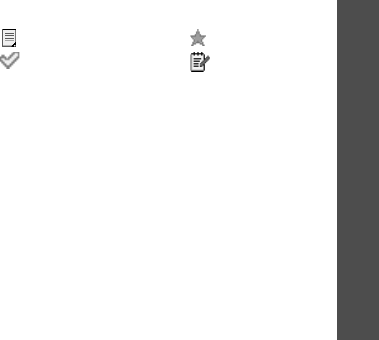
Menu functions
Organiser
(Menu 7)
63
•
alarm time
: enter the time for the alarm to
sound.
•
Repeat every year
: set the phone to
remind you of the anniversary every year.
4. Press <
Options
> and select
Save
to save the
anniversary.
Entering a task
1. Select a date on the calendar.
2. Press <
Options
> and select
New
→
Task
.
3. Enter information or change the settings:
•
Title
: enter the title for the task.
•
Task
: enter the task content.
•
Start date
: enter the starting date.
•
Due date
: enter the ending date.
•
Priority
: select a priority level.
4. Press <
Options
> and select
Save
to save the
task.
Entering a memo
1. Select a date on the calendar.
2. Press <
Options
> and select
New
→
Memo
.
3. Enter the memo text and press [Down].
4. Enter the date.
5. Press <
Options
> and select
Save
to save the
memo.
Consulting the calendar
Once you have scheduled items, the square brackets
appear on the corner of the date cell.
Viewing an item
1. Select a date on the calendar to display the
items for the day. The following icons indicate
the type of item:
2. Select an item to view its details.
From the item list, press <
Options
> to access the
following options:
•
View
: access the item.
•
New
: add a new item.
•
Completed
/
To do
: change the status of the
selected task.
•
Month view
: switch to the monthly view screen.
•
Week view
: switch to the weekly view screen.
•
Change date
/
Change due date
/
Reschedule
:
change the date of the item.
•
Delete
: delete the selected item.
•
Delete all
: delete all of the items for the
selected day.
•
Send schedule
/
Send task
: send the item via
SMS, MMS, e-mail, File messenger, or Bluetooth.
• Scheduled items • Anniversaries
• Tasks • Memos
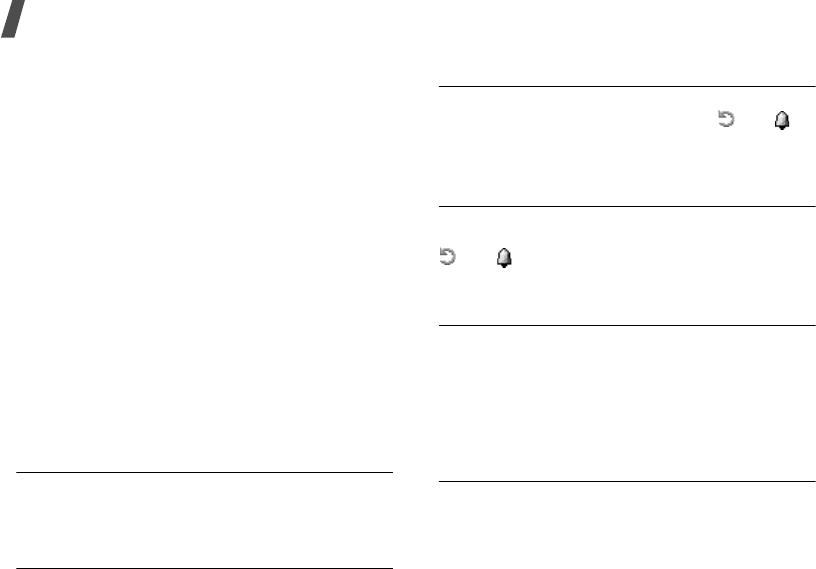
Menu functions
64
•
Send memo
: send the memo via SMS.
•
Print via Bluetooth
: print the item via a
Bluetooth-compatible printer. Some printers may
not be compatible with the phone.
Using calendar options
On the calendar, press <
Options
> to access the
following options:
•
View
: display the items stored for the selected
date.
•
New
: add a new item.
•
Week view
: display the weekly view screen.
•
Go to today
:
go to today’s date.
•
Go to date
:
enter a specific date.
•
Start date
: set whether the calendar starts with
Sunday or Monday.
•
Delete
: delete the items for the specific period.
•
Delete all
: delete all of the items in the
calendar.
Week view
(Menu 7.2)
You can view items for the selected week. A call on
the timetable indicates the presence of a scheduled
item. Select a cell for the date you want.
Today’s events
(Menu 7.3)
You can view items for the selected date.
Select an item to view its details. The item opens in
Edit mode.
Schedule
(Menu 7.4)
This menu displays the scheduled items. If you have
set the Repeat and Alarm options, the and
icons display.
Select a scheduled item to view its details.
Anniversary
(Menu 7.5)
This menu displays anniversaries you have created.
If you have set the Repeat and Alarm options, the
and icons display.
Select an anniversary to view its details.
Task
(Menu 7.6)
Use this menu to display tasks you have created.
The icons on the right indicate the importance; the
lower the number on the icon, the higher the
priority. A check mark appears in the status check
box if the task has been completed.
Select a task to view its details.
Memo
(Menu 7.7)
This menu displays memos you have created.
Select a memo to view its details.
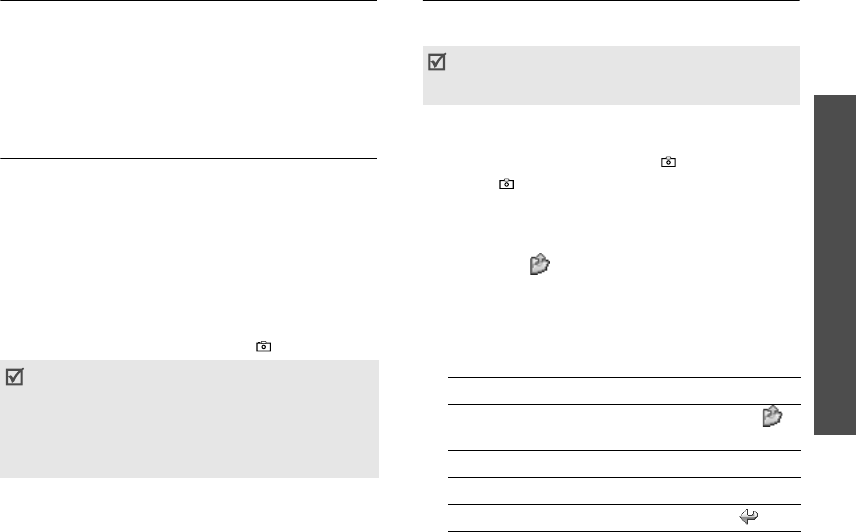
Menu functions
Camera
(Menu 8)
65
Missed event alarm
(Menu 7.8)
When you are unable to acknowledge an alarm for
an item, the phone stores the missed alarm until you
confirm it.
1. Select an item.
2. Press <
Confirm
> to confirm and delete the
item.
Memory status
(Menu 7.9)
This menu displays the number of items of each type
you have created, and the total number of items you
can store.
Camera
(Menu 8)
You can use the camera module embedded in your
phone to take photos and record videos.
To access this menu, press [
OK
] in Idle mode and
select
Camera
, or press and hold [ ].
Taking a photo
You can take photos in various modes. The camera
produces JPEG photos.
Taking a photo with the phone open
1. Access the
Camera
menu to turn on the camera.
You can also press and hold [ ] in Idle mode.
2. Press [ ] to switch between the interior camera
lens below the display and the exterior camera
lens on the external of the phone.
3. Make any desired adjustments.
• Press < > to use camera options.
next section
• Use the keypad to change the camera
settings or switch to other modes.
p. 67
4. Press [
OK
] to take a photo. The photo is saved in
the
Pictures
folder.
• Do not take photos of people without their
permission.
• Do not take photos in a place where cameras
are not allowed.
• Do not take photos in a place where you may
interfere with another person’s privacy.
When you take a photo in direct sunlight or in
bright conditions, shadows may appear on the
photo.
5.
To Press
use photo options <
Options
> or < >.
p. 67
delete the photo [
C
] and then <
Yes
>.
send the photo via MMS [
OK
].
p. 43
return to Capture mode <
Back
> or < >.

Menu functions
66
Using camera options in Capture mode
In Capture mode, press < > to access the
following options:
•
Take photo
: take a photo.
•
Record video
: switch to Record mode.
•
Switch camera
: switch between the interior
camera lens and the exterior camera lens.
•
Go to Photos
: access the
Pictures
folder.
•
Shooting mode
: take a photo in the following
modes:
Single shot
: take a photo in Normal mode. You
can select whether or not the camera
automatically saves a photo.
Multi shot
: take a series of action stills. You can
select the number of photos the camera will
take.
Mosaic shot
: take several stills and save them
in one frame. You can select the layout. Press
[
OK
] to take each photo.
•
Effects
: change the colour tone of the image.
•
Frames
: apply a decorative frame.
•
Timer
: set a time delay before the camera takes
a photo.
•
Zoom
/
Hide zoom
: display the zoom control bar
and zoom in or out by pressing [Up] or [Down],
or hide the control bar.
•
Brightness
/
Hide brightness
: display the
brightness control bar and adjust the brightness
by pressing [Left] or [Right], or hide the control
bar.
•
Camera settings
: change the default settings
for taking a photo:
Default name
: change the default prefix of file
names.
Default storage
: select the memory location to
store photos, if a memory card is inserted.
Viewfinder
:
select a preview screen.
Focus mode
: select a focus mode.
Shutter sound
: select the sound that you hear
when you press the shutter release key
.
Capture quality
:
select an image quality.
Image size
: select an image size.
Multi shot speed
: select the shooting speed in
Multi Shot mode.
Spot metering
: adjust the exposure based on a
specific area of the image. Select
On
to display
the spot focus frame in the middle of the image,
and change the exposure according to the
brightness of the image fragment in the frame.
White balance
: adjust the colour balance of the
photo. You can make your photo appear warmer
or cooler.
•
Camera shortcuts
: view the functions of the
keys you can use in Capture mode.
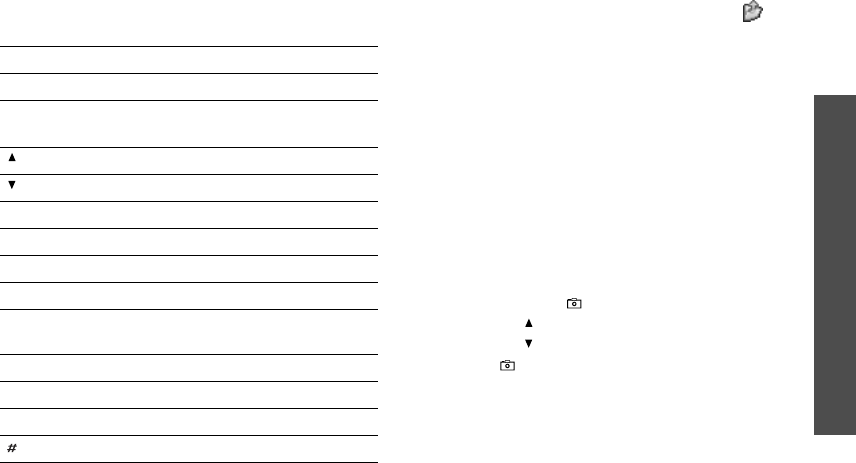
Menu functions
Camera
(Menu 8)
67
Using the keypad in Capture mode
You can use the keypad to customise your camera
settings in Capture mode.
Using photo options
After saving a photo, press <
Options
> or < > to
access the following options:
•
View
: access one of the multi-shot photos.
•
Send
: send the file via MMS, e-mail, File
messenger, or Bluetooth.
•
Viewfinder
: return to Capture mode.
•
Delete
: delete the file, or all of the multi-shot
photos.
•
Set as
:
set the photo as wallpaper for displays,
or as a caller ID image for a Contacts entry.
•
Go to Photos
: access the
Pictures
folder.
p. 55
•
Rename
:
change the file name.
Taking a photo with the phone closed
1. Press and hold [ ].
• Press [ ] to flip the image vertically.
• Press [ ] to view the mirror image.
2. Press [ ] to take a photo. The photo is
automatically saved.
Key Function
Left/Right Adjusts the brightness.
Up/Down Zooms in or out.(Not available for
the maximum size)
Flips the image vertically.
Shows the mirror image.
1
Switches to Record mode.
p. 68
2
Changes the image size.
3
Changes the image quality.
4
Changes the shooting mode.
5
Changes the colour tone or applies
a special effect.
7
Adds a decorative frame.
8
Sets the timer.
0
Goes to the
Pictures
folder.
Changes the preview screen.
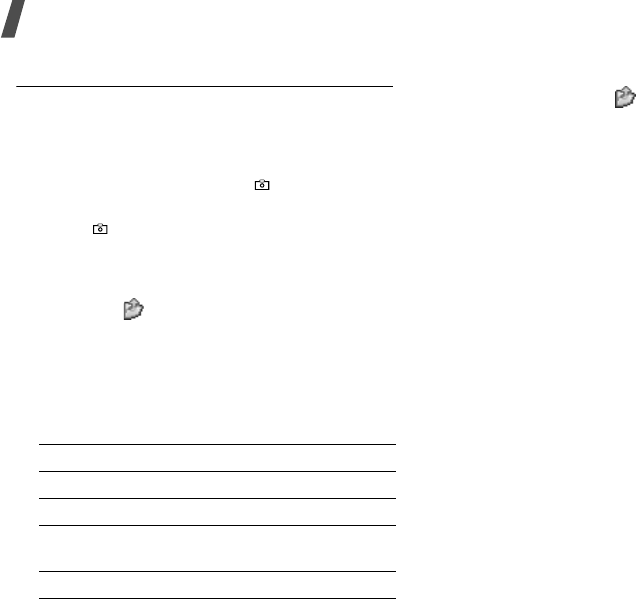
Menu functions
68
Recording a video
You can record a video of what is displayed on the
camera screen and save it.
Recording a video
1. Access the
Camera
menu to turn on the camera.
You can also press and hold [ ] in Idle mode.
2. Press [
1
] to switch to Record mode.
3. Press [ ] to switch between the interior camera
lens below the display and the exterior camera
lens on the external of the phone.
4. Make any desired adjustments.
• Press < > to use camera options.
next section
• Use the keypad to change the camera
settings or switch to other modes.
p. 69
5. Press [
OK
] to start recording.
6. Press [
OK
] to stop recording. The video is saved
in the
Videos
folder.
Using camera options in Record mode
In Record mode, press < > to access the following
options:
•
Record
: start recording.
•
Take photo
: switch to Capture mode.
•
Switch camera
: switch between the interior
camera lens and exterior camera lens.
•
Go to Videos
:
access the
Videos
folder.
p. 57
•
Effects
:
change the colour tone of the image.
•
Zoom
/
Hide zoom
: display the zoom control bar
and zoom in or out by pressing [Up] or [Down],
or hide the control bar.
•
Brightness
/
Hide brightness
: display the
brightness control bar and adjust the brightness
by pressing [Left] or [Right], or hide the control
bar.
•
Video settings
: change the following settings
for recording a video:
Default name
: change the default prefix of file
names.
Default storage
: select the memory location to
store video clips, if a memory card is inserted.
Quality
: select an image quality.
Recording time
: select a video recording mode.
Select
Limit for
MMS
to record a video suitable
for an MMS message.
7.
To Press
use video options <
Options
>.
p. 69
delete the video clip [
C
] and then <
Yes
>.
send the video clip via
MMS [
OK
].
p. 43
return to Record mode <
Back
>.
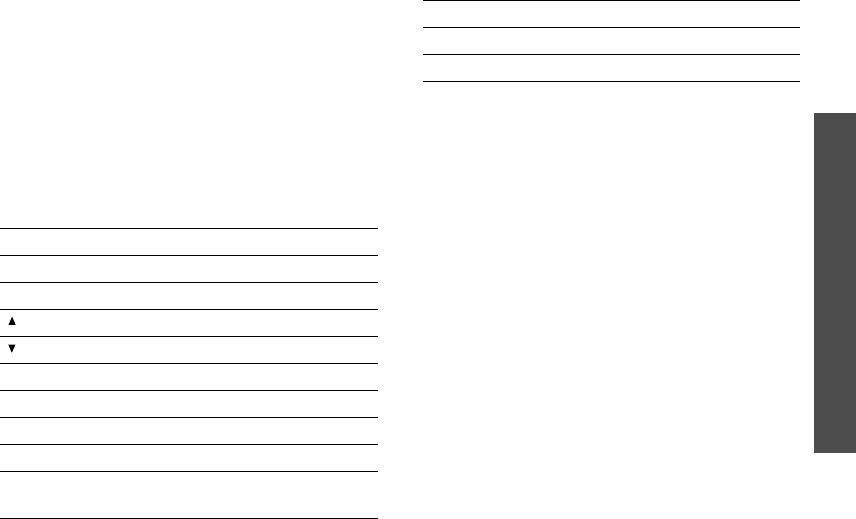
Menu functions
Camera
(Menu 8)
69
Select
Normal
to record a video within the limit
of the currently available memory. The length of
your video is determined by how much memory
has been used.
Size
: select a frame size.
Audio record
: turn the audio on or off.
•
Camcorder shortcuts
: view the functions of
the keys you can use in Record mode.
Using the keypad in Record mode
You can use the keypad to customise your camera
settings in Record mode.
Using video options
After saving a video clip, press <
Options
> to access
the following options:
•
Send
:
send the file via MMS, e-mail, File
messenger, or Bluetooth.
•
Play
:
play back the file.
•
Viewfinder
: return to Record mode.
•
Delete
: delete the file.
•
Go to Videos
: access the
Videos
folder.
p. 57
•
Rename
: change the file name.
Key Function
Left/Right Adjusts the brightness.
Up/Down Zooms in or out.
Flips the image vertically.
Shows the mirror image.
1
Switches to Capture mode.
p. 65
2
Changes the frame size.
3
Changes the image quality.
4
Changes the video recording mode.
5
Changes the colour tone or applies a
special effect.
7
Mutes or unmutes audio.
0
Goes to the
Videos
folder.
Key Function
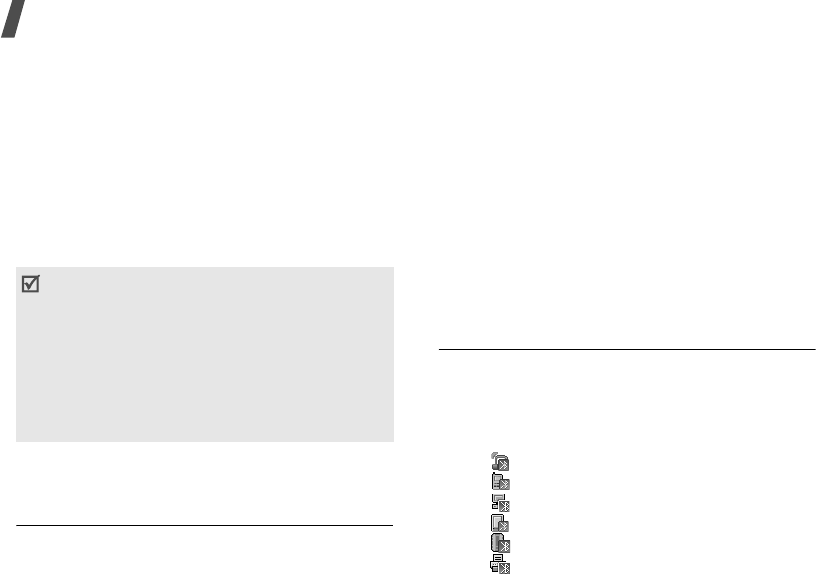
Menu functions
70
Bluetooth
(Menu 9)
Using Bluetooth wireless, you can connect the phone
wirelessly to other Bluetooth devices and exchange
data with them, talk hands-free, or control the
phone remotely.
Bluetooth technology allows free wireless
connections between all Bluetooth-compliant
devices within a range of 10 metres. Since the
devices communicate using radio waves, they do not
need to be in line of sight to each other.
To access this menu, press [
OK
] in Idle mode and
select
Bluetooth
.
Setting up the Bluetooth feature
The
Bluetooth
menu provides the following
options:
•
Activation
: activate or deactivate the Bluetooth
feature.
•
My devices
:
search for connectable Bluetooth
devices.
•
My phone’s visibility
: allow other Bluetooth
devices to locate to your phone, or not.
•
My phone’s name
: assign a Bluetooth device
name to your phone, which is then displayed on
other devices.
•
Secure mode
: determine if the phone asks for
your confirmation when other devices access
your data.
•
Bluetooth service
: display available Bluetooth
services.
Searching for and pairing with a
Bluetooth device
1. From the
Bluetooth
menu, select
My devices
.
2. Select
Search new device
.
After searching, a list of devices to which you can
connect displays. The following icons indicate the
type of device:
• Hands-free car kit or headset
• Mobile phone
• Computer
• PDA
• Unknown device
• Printer
• If there are obstacles between the devices,
the
operating distance may be reduced.
• It is recommended that you do not use the
Bluetooth feature while using multimedia
features, such as voice recorder, camera,
and
media player, or vice versa, for the better
performance.
• Some devices may not be compatible with
your
phone.

Menu functions
Bluetooth
(Menu 9)
71
The colour of the icon indicates the status of the
device:
• Grey for unpaired devices
• Blue for paired devices
• Red for devices that are currently connected
to your phone
3. Select a device.
4. Enter a Bluetooth PIN and press <
OK
>.
This
code is used just once and you do not need to
memorise it.
When the owner of the other device enters the
same code, pairing is complete.
Using device options
From the device list, press <
Options
> to access the
following options:
•
Connect
: connect to a headset or hands-free car
kit.
•
Disconnect
: end the connection with the
connected device.
•
Browse device
: search for data from the device
and import data directly to your phone.
•
Service list
: access the Bluetooth service list of
the device.
•
Authorise device
/
Unauthorise device
:
determine whether or not the phone asks you to
permit connection when other devices try to
connect to your phone.
•
Delete
: remove the selected device or all
devices from the list.
•
Rename
: rename the selected device.
Sending data via Bluetooth
1. Activate the Bluetooth feature.
2. Select the application in which the item you want
to send is stored.
3. Scroll to the item you want and press
<
Options
>.
4. Select
Send name card
/
Send
/
Send schedule
/
Send task
→
Via
bluetooth
.
5. Select
Search new device
.
The phone searches for devices within range and
displays a list of available devices.
6. Select a device.
7. If necessary, enter the Bluetooth PIN needed for
pairing and press <
OK
>.
Some devices, especially headsets or hands-free
car kits, may have a fixed Bluetooth PIN, such as
0000
. If the other device has one, you must enter
the code.
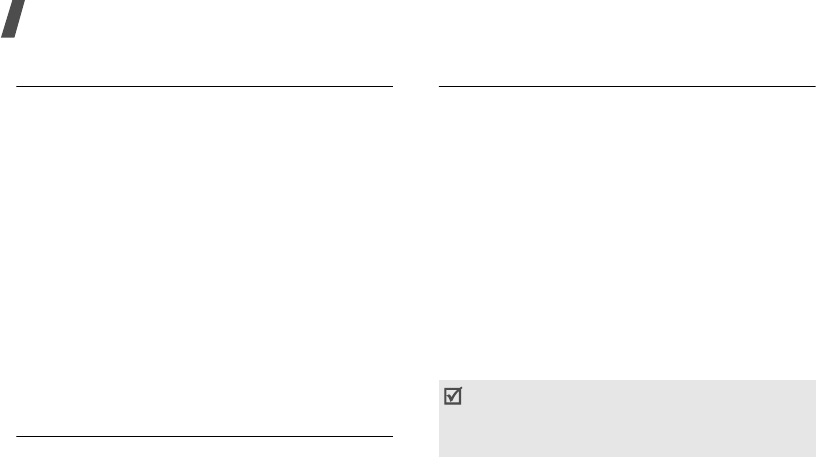
Menu functions
72
Receiving data via Bluetooth
To receive data via Bluetooth, your phone’s
Bluetooth feature must be active and its visibility
must be enabled.
1. If an unauthorised Bluetooth device sends data
to your phone, press <
Yes
> to allow the device
to access your phone.
2. Press <
Yes
> to receive data.
Applications
(Menu *)
You can use convenient features, such as a voice
recorder, world clock, calculator, and converter. You
can also have your own cyber pet and view a tube
map.
To access this menu, press [
OK
] in Idle mode and
select
Applications
.
SAT
(Menu *.1)
This menu is available if you use a USIM/SIM card
that supports SIM Application Toolkit menus and
provides additional services, such as news, weather,
sports, entertainment, and location services.
Available services may vary, depending on your
service provider’s plans.
For details, see your
USIM/
SIM card instructions or
contact your service provider.
mPet
(Menu *.2)
You can select and adopt your own cyber dogs. Help
them grow up by feeding and playing with them just
as you would in real life. You can also train your
dogs,
and let it have a puppy with another
mPet
user’s dog
.
Adopting a dog
1. Press <
Yes
> to adopt a new dog.
2. Scroll to the dog you want by pressing [Left] or
[Right].
You can make the dog walk or turn by pressing
<
Options
> and selecting
Animate
or
Turn
.
3. Press [
OK
].
4. Enter the name of the dog and press <
Save
>.
5. Press <
Yes
> to adopt the dog.
Taking care of your dog
When you access the
mPet
menu, the phone
displays an icon indicating how your dog is feeling,
its current need, or his physical condition on the
bottom line of the display. Take care of your pet
accordingly. Depending on the icon, it may not obey
your commands.
You can adopt a dog that other people have raised
by receiving a dog adopting message via SMS.
When you receive a message, select <
Yes
>. The
dog is stored in the
Pet Inventory
folder.
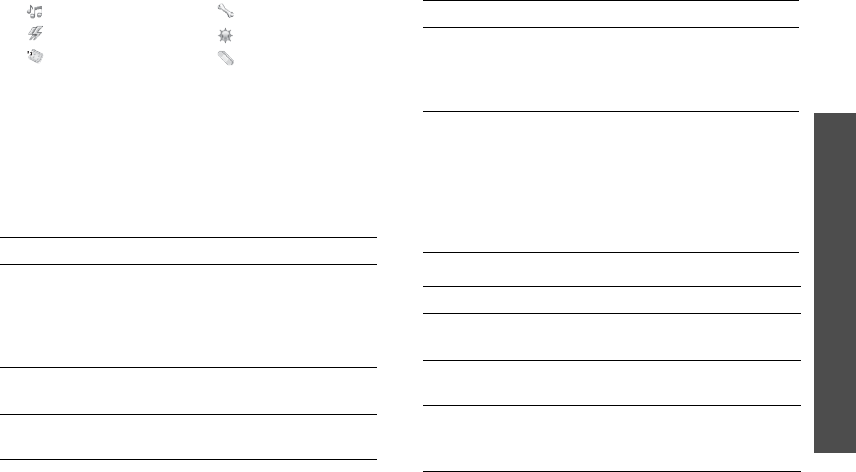
Menu functions
Applications
(Menu *)
73
Select a location where you want to play with your
dog by pressing <
Options
> and selecting
Location
. For each location, you can do various
activities with your dog.
Your pet may refuse to participate in an activity due
to its current state. For example, if your dog is sick,
it may refuse to eat until you help it feel better.
Garden
Living room
• Happy • Hungry
• Angry • Calm
• Tired • Sick
Activity Instructions
DING DONG
game Press [
1
] or walk to the musical
notes. Imitate the notes your dog
plays by pressing the same numbers,
in the same order. After playing, your
dog gets a snack.
Going to
living room Press [
2
] or walk to the front door.
Garden walk Press [
3
] or walk to the flowers. Your
dog plays with a butterfly or bird.
STANGA
game Press [
4
] or walk to the ball. Using
the Navigation keys, hit the balls with
the paddle. After playing, your dog
gets a snack.
Going out Press [
5
] or walk to the gate. You can
send your dog to meet a dog friend
for visiting, racing, or creating a new
puppy to another phone that has the
mPet feature. After meeting a dog
friend, you get a decorative item for
your dog.
Activity Instructions
Going to the
garden Press [
1
] or walk to the door.
Going to the
kitchen Press [
2
] or walk to the entrance of
the kitchen.
Decorations Press [
3
] or walk to the closet.
Decorate your dog with decorations,
such as a bow tie, hairpin, or medal.
Activity Instructions

Menu functions
74
Kitchen
Bedroom
Using various options
On the location screen, press <
Options
> to access
the following options:
•
Train
: train your dog.
•
Commend
: praise your dog or pet it if it is
behaving well.
•
Discipline
: warn or punish your dog if it
behaving bad.
•
Location
: select a location in which you want to
play with your dog.
•
Pet Inventory
: view the dogs you have
adopted. Press <
Options
> to access the
following options:
View Status
: check the status of the selected
dog.
Rename
: rename your dog.
Say Goodbye
: give the selected dog to another
person or say farewell to your dog.
Adopt New Pet
: adopt a new dog. You can
adopt up to 5 dogs.
Pick
: make the selected dog your active pet.
•
Pet Status
: view all influencing factors of your
pet’s well being, and use it to indicate how to
best take care of your dog.
•
Family Tree
: view a family tree for dogs created
on your phone.
Activity Instructions
Going to the
living room Press [
1
] or walk to the entrance of
the living room.
Going to the
bedroom Press [
2
] or walk to the door.
Feeding Press [
3
] or walk to the food bowl to
feed your dog.
Today’s saying Press [
4
] or walk to the cards to
view today’s saying.
Snacks Press [
5
] or walk to the snack tray
to give snacks to your dog.
Activity Instructions
Going to the
kitchen Press [
1
] or walk to the door.
Cleaning Press [
2
] or walk to the cleaning
basket to give your dog a good
cleaning.
Bedtime Press [
3
] or walk to the doghouse to
let your dog sleep.
Healing Press [
4
] or walk to the shot to help
your dog heal.

Menu functions
Applications
(Menu *)
75
•
Settings
: access the following:
Sound
: select if the phone uses sounds or
vibration when you play with your dog.
Navigation
: select a navigation type,
Shortcut
mode
or
Walking mode
.
•
Help
: view the help screen for using the mPet
feature
.
Training your dog
1. On the location screen, press <
Options
> and
select
Train
.
2. Select a command to train your dog.
Depending on the dog’s age, you can train it to
sit, roll, turn, bark, or give paw. Repeat
commands multiple times until the pet learns the
trick.
Voice recorder
(Menu *.3)
Use this menu to record voice memos. A voice
memo can be up to one hour long.
Recording a voice memo
1. Press [
OK
] to start recording.
2. Speak into the microphone.
Press [
OK
] to pause or resume the recording.
3. Press <
Stop
> or [Down]. The voice memo is
saved automatically.
4. Press [
OK
] to review the memo, or press [Up] to
record additional memos.
Playing a voice memo
1. From the voice recorder screen, press
<
Options
> and select
Go to sounds
.
2. Select a voice memo from the
Voice memos
folder. The memo plays.
During playback, use the following keys:
Using voice recorder options
After playback, press <
Options
> to access the
following options:
•
Play
: play the selected voice memo in Review
mode.
•
Record
: record a new voice memo.
•
Send
: send the file via MMS, e-mail, File
messenger, or Bluetooth.
•
Activate key
: get a new licence key when the
key for the selected DRM file expires.
•
Reactivate key
: get another licence key even
when the key for the selected DRM file has not
expired.
Key Function
OK
Pauses or resumes playback.
Left Moves backward in a file.
Right Skips forward in a file.
/
Adjusts the volume.
Down Stops playback.

Menu functions
76
•
Set as ringtone
: set the file as your ringtone
for voice calls or video calls.
•
Set as caller ID
: set the file as a ringtone for a
Contacts entry.
•
Key management
: manage licence keys you
have acquired.
•
Go to sounds
: access the voice memo list.
•
Delete
: delete the file.
•
Rename
: change the file name.
•
Visible to Bluetooth
/
Hidden from Bluetooth
:
share the file so that other Bluetooth devices
cannot access it, or hide the file with other
Bluetooth devices.
•
Details
: access the file properties.
•
Record settings
: customise the default settings
for the voice recorder:
Default name
: change the default prefix of file
names.
Recording time
:
select a maximum recording
time.
World clock
(Menu *.4)
Use this menu to set your local time zone and find
out the current time in another part of the world.
Setting the local time zone
1. From the world map, press [Left] or [Right] to
scroll to the city you want on the upper line ( ).
As the time line moves, the time and date of the
given zone display.
2. Press [
OK
] to save the city as your local time
zone.
Viewing world time
1. From the world map, move to the lower line
().
2. Press [Left] or [Right] to scroll to the city you
want.
3. Press [
OK
] to save the time zone.
Applying daylight saving time
1. From the world map, press <
Options
> and
select
Summer time
.
2. Press [
OK
] to select the time zones you want.
3. Press <
Select
>.
4. Press [
OK
] to save the time zone.
Calculator
(Menu *.5)
Use this menu to perform basic arithmetic functions
such as addition, subtraction, multiplication, and
division.
Performing a calculation
1. Enter the first number.
Press [ ] to include a decimal point.
2. Press one of the Navigation keys to access the
math function you want.
3. Enter the second number.
4. Press [
OK
] to view the result.

Menu functions
Applications
(Menu *)
77
5. If necessary, repeat from step 2 to continue the
calculation.
Using calculator options
Press <
Options
> to access the following options:
•
Equal
: view the result.
•
Recent calculation
: display the last result you
calculated.
•
Save to memory
: save a value into the
calculator memory.
•
Recall memory
: retrieve the saved value.
•
Clear memory
: clear the saved value.
Converter
(Menu *.6)
Use this menu for common conversions, such as
currency and temperature.
Performing a conversion
1. Select a converter.
2. Press [Left] or [Right] to select the original unit
and press [Down].
3. Enter the value to be converted and press
[Down].
• Press [ ] to insert a decimal point.
• Press [ ] to change the temperature to
above zero (+) or below zero (-).
4. Press [Left] or [Right] to select the unit to which
you want to convert.
The equivalent value for the amount you entered
displays.
Using converter options
Press <
Options
> to access the following options:
•
Clear
: clear the current values.
•
Reverse
: reverse the conversion.
•
Currency rates
: display the currency rate list.
Tube map
(Menu *.7)
You can view the tube maps of London, Paris, Milan,
and Berlin.
Using a map
1. Select a city.
2. Press the Navigation keys to move to different
sections of the map.
3. Press [
OK
] to zoom in on different sections of
the map.
Press <
Back
> to zoom out.
Using tube map options
On the tube map screen, press <
Options
> to
access the following options:
•
Zoom in
: zoom in on the map.
•
Zoom out
: zoom out.
•
Search
: search for the station you entered.

Menu functions
78
•
Settings
: set the tube map settings.
Set default city
: select a default tube map. If
you select
Always ask
, the phone will display
the city selection screen each time you access
this menu.
Map on
: set whether the phone shows the
thumbnail on the enlarged map.
•
Help
: view the help screen for reading the tube
map.
Alarms
(Menu 0)
Use this menu to set alarms to sound at specific
times. The alert type for a normal alarm corresponds
to the call alert type settings in the currently
selected profile. A wake-up alarm is not be affected
by your profile setting.
To access this menu, press [
OK
] in Idle mode and
select
Alarms
.
Setting an alarm
1. Select the type of alarm.
2. Set each alarm option:
•
Alarm
: activate the alarm.
•
Time
: enter the time for the alarm to sound.
•
Repeat
: select a repeat option.
•
Alert tone
: select an alarm tone.
3. Press <
Options
> and select
Save
.
Stopping an alarm
When the time for an alarm comes and the alarm
sounds:
• For a non-wake-up alarm, press any key.
• For a wake-up alarm, press <
OK
> or [
OK
].
Press any key, except for <
OK
> and [
OK
], to
cause it to sound again after 5 minutes.
Deactivating an alarm
1. Select the alarm you want to deactivate.
2. Select
Off
on the
Alarm
line.
3. Press [
OK
].
Setting alarms to sound when the phone
is off
From the Alarms screen, select
Auto power
→
On
.
If the phone is off when it is time for the alarm to
sound, the phone switches on and sounds the alarm.

Menu functions
Settings
(Menu #)
79
Settings
(Menu #)
The
Settings
menu provides you with various
setting options to customise the phone to your
preferences and needs. You can also reset the
settings to their default status.
To access this menu, press [
OK
] in Idle mode and
select
Settings
.
Profiles
(Menu #.1)
Your phone provides you with sound profiles that
allow you to quickly and easily change the sound
settings of the phone for different events or
situations. Use this menu to adjust the properties of
each profile and activate the profile you need.
Editing a profile
1. Scroll to the profile you want.
2. Press <
Options
> and select
Edit
.
3. Change the sound settings:
•
Call alert type
: select an alert type for the
call ringer.
•
Voice call ringtone
: select a ringtone for
voice calls.
•
Video call ringtone
: select a ringtone for
video calls.
•
Tone volume
: adjust the volume for the call
ringer.
•
Message alert type
: select an alert type for
the message ringer.
•
Message alert tone
: select a ringtone for
the message ringer.
•
Message alert repetition
: select if the
phone repeatedly reminds you of a new
message.
•
Phone sounds
: turn the various sounds on
the phone on or off:
All on
: enable all tones.
Popup box alerts
: set the phone to beep
when a pop-up window displays.
Power on/off
: set the phone to beep when
you turn it on or off.
Folder open/close
: set the phone to sound
when you open or close it.
Minute minder
: set the phone to beep
every minute during an outgoing call to keep
you informed of the length of your call.
Call connect tone
: set the phone to beep
when an outgoing call is connected to the
system.
Call end tone
: set the phone to beep when a
call is disconnected by the other person or
due to a faded signal.
Alerts on call
: set the phone to beep when
you receive a new message or when the time
for an alarm comes during a call.
•
Key tones
: select a tone which sounds when
you press a key.

Menu functions
80
•
Key tone volume
: adjust the volume of the
key tones.
•
Call answer mode
: (For Car) select how to
answer an incoming call.
4. When you have finished, press <
Options
> and
select
Save
.
Changing an active profile
From the profile list, select the profile you want.
Time & date
(
Menu
#.2)
Use this menu to change the time and date
displayed on your phone.
•
Time
: enter the current time. To select AM or PM
for 12-hour time format, press [Right].
•
Date
:
enter the current date.
•
Time format
: select a time format.
•
Date format
:
select a date format.
•
Summer time
: select to apply daylight saving
time.
•
Auto update
: activate the auto time update
feature. Your phone will read the MCC (Mobile
Country Code) from the network and
automatically update the current time for the
country that you are in when you travel abroad.
Phone
(Menu #.3)
Many different features of your phone’s system can
be customised to suit your preferences.
Language
(Menu #.3.1)
Use this menu to select a language for the display
text or T9 input mode. If you select
Automatic
, the
phone uses the same language as the USIM/SIM
card.
Shortcuts
(Menu #.3.2)
You can use the Navigation keys as shortcut keys to
access specific menus directly from Idle mode. Use
this menu to assign a shortcut to a key.
Assigning a shortcut menu
1. Select a key to be used as a shortcut key.
2. Select a menu to be assigned to the key.
Using shortcut options
On the Shortcuts screen, press <
Options
> to
access the following options:
•
Assign
: assign a shortcut menu.
•
Change
: change a shortcut menu assignment.
•
Remove
: deactivate the shortcut assignment to
the selected key.
•
Remove all
: deactivate all shortcut
assignments.
Time information may not be updated when
you move to one time zone to another within a
country.

Menu functions
Settings
(Menu #)
81
Active folder
(Menu #.3.3)
Use this menu to answer incoming calls by opening
the phone.
Anykey answer
(Menu #.3.4)
Use this menu to answer an incoming call by
pressing any key, except for <
Reject
> and [ ].
Volume key
(Menu #.3.5)
Use this menu to set whether the phone mutes the
call ringer or rejects a call if you press and hold
[
/
] when a call comes in.
Key management
(Menu #.3.6)
Use this menu to manage the licence keys you have
acquired to activate media contents locked by DRM
systems.
Press <
Options
> to access the following options:
•
View
: open the corresponding media item.
•
Delete
: delete the selected licence key.
•
Go to My Messages
: access the message that
contains the media content.
•
Go to File manager
: access the corresponding
file folder.
•
Details
: access the properties of the licence key.
Cover keypad lock
(Menu #.3.7)
Use this menu to lock the exposed keys to keep
accidental presses from affecting your phone’s
operation when the phone is closed.
Display
(Menu #.4)
Use this menu to change settings for the display.
Greeting message
(Menu #.4.1)
Use this menu to enter the greeting that is displayed
on the main display or external display.
Wallpaper
(Menu #.4.2)
You can change the background image that is
displayed on the main display. You can select one of
the images in the
Images
folder, or create a photo
slide of your favourite image.
Calendar
(Menu #.4.3)
Use this menu to display the calendar of the current
month on the idle screen.
Cover LCD
(Menu #.4.4)
Use this menu to select an image or enter text to be
displayed on the external display.
•
Clock
: select a clock type.
•
Cover title
: enter the text you want.
•
Wallpaper
: press <
Change
> and select an
image. If necessary, select the portion of the
image to be displayed.
LCD brightness
(Menu #.4.5)
Use this menu to adjust the brightness of the main
display.

Menu functions
82
Backlight
(Menu #.4.6)
You can select the length of time the backlight or
display stays on.
•
On
: select the length of time the backlight stays
on in times of inactivity.
•
Dim
: select the length of time the display stays
on in Dim mode after the backlight turns off.
After a specified time, the display turns off.
Dialling display
(Menu #.4.7)
Use this menu to customise the settings for the
numbers entered and the background colour of the
display while dialling.
Touch light
(Menu #.4.8)
Use this menu to turn on or off the backlight of the
media player control keys.
Call
(Menu #.5)
Use this menu to set options for call functions.
Caller ID
(Menu #.5.1)
This network service allows you to hide your phone
number from the person you are calling. If you
select
By network
, the phone will use the default
setting provided by the network.
Diverting
(Menu #.5.2)
This network service reroutes incoming calls to a
different phone number that you specify.
1. Select the type of calls to be diverted.
2. Select a call diverting option:
•
Always
: divert all calls.
•
Busy
: divert calls when you are on another
call.
•
No
reply
: divert calls when you do not
answer the phone.
•
Unreachable
: divert calls when you are not
in your service area or when your phone is
switched off.
•
Cancel
all
: cancel all call diverting options.
3. Enter the number to which the calls will be
diverted in the
Divert to
line.
4. If you selected
No reply
, move to the
Waiting
time
line and select the length of time the
network delays before diverting a call.
5. Press <
Options
> and select
Activate
. To
deactivate the call diverting, select
Deactivate
.
Barring
(Menu #.5.3)
This network service allows you to restrict your calls.
1. Select the type of calls to be barred.
2. Select a call barring option:
•
All
outgoing calls
: prohibit all outgoing
calls.
Some networks do not allow the user to change
this setting.

Menu functions
Settings
(Menu #)
83
•
Outgoing int’l calls
: prohibit international
calls.
•
Int’l calls exc. home
: only allow calls to
numbers within the current country when you
are abroad, and to your home country.
•
All
incoming calls
: prohibit incoming calls.
•
Incoming calls when roaming
: prohibit
incoming calls when you use your phone
outside of your home service area.
•
Cancel
all
: cancel all call barring settings,
allowing calls to be sent and received
normally.
3. Enter the call barring password supplied by your
service provider.
4. Press <
Options
> and select
Activate
. To
deactivate the call barring, select
Deactivate
.
Waiting
(Menu #.5.4)
This network service informs you when someone is
trying to reach you while you are on another call.
1. Select the type of calls to which the call waiting
option will apply.
2. Press <
Options
> and select
Activate
. To
deactivate the call waiting, select
Deactivate
.
Auto redial
(Menu #.5.5)
Use this menu to make up to ten attempts to redial
a phone number after an unsuccessful call.
Closed user group
(Menu #.5.6)
Use this menu to set incoming and outgoing calls to
be restricted to a selected user group (CUG). For
details about how to create a closed user group,
contact your service provider.
•
Use user group
: activate CUG index numbers.
•
Outside access
: enable calls to numbers other
than those in the Closed user group. This feature
depends on the nature of your CUG subscription.
•
Default group
: enable the default CUG, if you
have set one with your service provider. When
making a call, you are given the option of using
your default CUG, instead of selecting one from
the list.
•
Group index
: add, delete, or activate CUG
index numbers.
Video call
(Menu #.5.7)
Use this menu to change the default settings for
using the video call feature.
•
Show me
: change the video camera settings for
receipt of video calls:
Optionally
: you can select whether or not the
video camera is used each time you answer a
video call.
Always
: the camera is always used.
You can change the call barring password
obtained from your service provider. From the call
type list, press <
Options
> and select
Change
password
.

Menu functions
84
•
Retry by
: set what to do when a video call does
not connect:
Voice call
: the phone retries with a voice call.
Multimedia message
: the phone will turn on
the camera and switch to Record mode so that
you can record a video and send it as an MMS
message.
None
: the phone does not retry.
Connectivity
(Menu #.6)
Use this menu to set options for connection available
on your phone.
Network
(Menu #.6.1)
Use this menu to change the settings for connecting
to your cellular network.
•
Network selection
: select to either manually
select the network to be used when roaming
outside of your home area, or to let the network
be chosen automatically. You can select a
network other than your home network only if
there is a valid roaming agreement between the
two.
•
Network mode
: select the network you use:
Automatic
: the phone scans for available
networks.
GSM 900/1800
: the phone operates in the
combined GSM 900/1800 network.
GSM 1900
: the phone operates in the GSM
1900 network. This option is only available in the
U.S.A.
UMTS
: the phone operates in UMTS (3G
network) networks. You can get a higher speed
quality than on lower generation networks, and
use advanced data and information services,
such as video calls.
Connections
(Menu #.6.2)
Use this menu to create and customise the profiles
containing the settings for connecting your phone to
the network. You need these settings to use the web
browser or send MMS messages or e-mails.
Creating a profile
1. Press <
Options
> and select
New
.
2. Specify profile parameters:
•
Set name
: enter a profile name.
•
Access name
: edit the access point name
used for the address of the GPRS network
gateway.
•
Auth type
: choose the type of
authentication used.
•
User ID
: enter the user ID.
Your phone is set up by default for connecting to
the network. If you change the settings without
first checking with your service provider, the web
browser, MMS, and e-mail features may not work
properly.

Menu functions
Settings
(Menu #)
85
•
Password
: enter the user password.
•
Protocol
: select the protocol from among
WAP
,
HTTP
, and
Other
.
•
Home URL
: enter the URL address of the
page to be used as your homepage.
•
Gateway address
: (WAP only) enter the
gateway address of the proxy server.
•
Proxy address
/
Port
: (HTTP only) set the
proxy server address and port.
•
Secure connection
: (WAP only) turn the
secure mode on or off.
•
Linger time (sec.)
: set a time period after
which the network is disconnected if there
has been no new data traffic in that time.
•
Advanced settings
:
provide you with the
following options:
Static IP
: specify if you want to manually
enter an IP address; see the
Local phone
IP
option. If you want the IP address to be
automatically assigned by the server, remove
the check mark.
Local phone IP
: enter the IP address
obtained from the network operator, if you
checked the
Static IP
option.
Static DNS
: specify if you want to manually
enter the Domain Name Server (DNS)
address; see the
Server 1
/
Server 2
option.
If you want the address to be automatically
assigned by the server, remove the check
mark.
Server 1
/
Server 2
: enter the Domain Name
Server (DNS) addresses.
Traffic class
: select the traffic class.
3. Press <
Save
> to save the profile.
Using profile options
From the profile list, press <
Options
> to access the
following options:
•
View
: view the properties of the selected profile.
•
Edit
: edit the selected profile.
•
New
: add a new profile.
•
Rename
: change the profile name.
•
Delete
: delete the profile.
•
Restore
: restore the changed settings to the
default status.
You cannot edit or delete the default connection
profiles.

Menu functions
86
Application settings
(Menu #.7)
You can customise the settings for using applications
available on the phone.
Internet
(Menu #.7.1)
Use this menu to select a connection profile to be
used for accessing the Internet. You can also create
or edit a profile.
p. 84
Messages
(Menu #.7.2)
Use this menu to change the default settings for
using the messaging services.
p. 51
Contacts
(Menu #.7.3)
Use this menu to change the settings for using
Contacts.
p. 36
Camera
(Menu #.7.4)
Use this menu to change the default settings for
taking photos.
p. 66
Video recorder
(Menu #.7.5)
Use this menu to change the default settings for
recording videos.
p. 68
Voice recorder
(Menu #.7.6)
Use this menu to change the default settings for the
voice recorder.
p. 76
Media player
(Menu #.7.7)
Use this menu to change the default settings for
playing media files in the media player.
p. 38
VOD
(Menu #.7.8)
Use this menu to activate a connection profile to be
used for accessing streaming servers to use VOD
(Video on Demand) services. You can also create or
edit a profile.
p. 84
Security
(Menu #.8)
Use this menu to protect the phone against
unauthorised use by managing the several access
codes of your phone and USIM/SIM card.
Phone lock
(Menu #.8.1)
Use this menu to protect the phone from
unauthorised use. When this feature is enabled, you
must enter a 4- to 8-digit phone password each time
the phone is switched on.
The password is preset to
00000000
. To change the
password, use the
Change phone password
menu.
If you enter an incorrect PIN/PIN2 three times, the
USIM/SIM card is blocked. To unblock it, you need
to enter your PUK/PUK2 (Personal Unblocking
Key). The codes are supplied by your network
operator.

Menu functions
Settings
(Menu #)
87
SIM lock
(Menu #.8.2)
This menu allows your phone to work only with the
current USIM/SIM by assigning a USIM/SIM lock
code. You must enter the USIM/SIM lock code to use
a different USIM/SIM card.
PIN lock
(Menu #.8.3)
The 4- to 8-digit PIN (Personal Identification
Number) protects your USIM/SIM card against
unauthorised use. When this feature is enabled, the
phone requires your PIN each time it is switched on.
Fixed dialling mode
(Menu #.8.4)
If supported by your USIM/SIM card, Fixed Dialling
Number (FDN) mode restricts your outgoing calls to
a limited set of phone numbers. When this feature is
enabled, you can make calls only to phone numbers
stored on the USIM/SIM card.
Change phone password
(Menu #.8.5)
Use this menu to change your phone password.
Privacy lock
(Menu #.8.6)
Use this menu to lock access to messages, media
files, Contacts entries, call logs, or calendar data.
When a privacy option is enabled, you must enter
the phone password to access the locked items.
Change PIN code
(Menu #.8.7)
Use this menu to change your PIN. The PIN lock
feature must be enabled to change the PIN.
Change PIN2 code
(Menu #.8.8)
If supported by your USIM/SIM card, use this menu
to change your current PIN2.
Mobile tracker
(Menu #.8.9)
When someone tries to use your phone with another
USIM/SIM card, the phone will automatically send
the preset tracking message to your family or
friends. You can check the phone number from
which the messages are sent and then track your
phone. This feature is useful when the phone is
stolen or lost.
1. Enter the phone password and press
<
Confirm
>.
2. Specify the following options:
•
Activation
: activate or deactivate the Mobile
tracker feature.
•
Recipients
: specify phone numbers to which
you want to send the tracking messages.
Sending of the tracking message will be billed to
the user of the unauthorised USIM/SIM card. To
use your phone with any other USIM/SIM card,
you must first deactivate the Mobile tracker
feature.

Menu functions
88
•
Sender
: enter the sender’s name.
•
Messages
: check the preset tracking
message text.
3. When you have finished, press <
Save
>.
4. Press <
Accept
> if you agree to the terms and
conditions of service listed on the screen.
Memory status
(Menu #.9)
Use this menu to check the amount of memory
being used for storing data, such as messages,
media, calendar data, or contacts entries.
Operator settings
(Menu #.0)
Use this menu to set a service provider according to
the SIM card you are using. When you select a
service provider, the phone will automatically turn
itself off and then back on. You can then see the
profiles corresponding to the service provider in the
connection menus.
This menu may not be shown depending on your
service provider.
Reset settings
(Menu #.*)
Use this menu to reset the phone’s settings you
have changed and clear all data you have added.
1. Enter the phone password and press
<
Confirm
>.
2. Press <
Yes
>. The phone automatically turns
itself off and then back on.
The password is preset to
00000000
. You can
change this password.
p. 87

89
Solve problems
Help and personal needs
To save the time and expense of an unnecessary
service call, perform the simple checks in this
section before contacting a service professional.
When you switch on your phone, the following
messages may appear:
“Please insert SIM card”
• Be sure that the USIM/SIM card is correctly
installed.
“Phone lock”
• The automatic locking function has been
enabled. You must enter the phone’s password
before you can use the phone.
“PIN lock”
• You are using your phone for the first time. You
must enter the PIN supplied with the USIM/SIM
card.
• The PIN lock feature is enabled. Every time the
phone is switched on, the PIN has to be entered.
To disable this feature, use the
PIN lock
menu.
“PUK lock”
• The PIN code was entered incorrectly three
times, and the USIM/SIM card is now blocked.
Enter the PUK supplied by your service provider.
“No service,” “Network failure,” or “Not done”
displays
• The network connection has been lost. You may
be in a weak signal area. Move and try again.
• You are trying to access an option for which you
have no subscription with your service provider.
Contact the service provider for further details.
You have entered a number but it was not
dialled
• Be sure that you have pressed [ ].
• Be sure that you have accessed the right cellular
network.
• Be sure that you have not set an outgoing call
barring option.
Your correspondent cannot reach you
• Be sure that your phone is switched on. ([ ]
pressed for more than one second.)
• Be sure that you are accessing the correct
cellular network.
• Be sure that you have not set an incoming call
barring option.
Your correspondent cannot hear you speaking
• Be sure that you have switched on the
microphone.
• Be sure that you are holding the phone close
enough to your mouth. The microphone is
located at the bottom of the phone.

90
The phone starts beeping and “Low battery”
flashes on the display
• Your battery is insufficiently charged. Recharge
the battery.
The audio quality of the call is poor
• Check the signal strength indicator on the
display ( ). The number of bars indicates the
signal strength from strong ( ) to weak ( ).
• Try moving the phone slightly or moving closer
to a window if you are in a building.
No number is dialled when you re-call a
Contacts entry
•Use the
Search contact
feature to ensure the
number has been stored correctly.
• Re-store the number, if necessary.
The battery does not charge properly or the
phone sometimes turns itself off
• Wipe the charging contacts both on the phone
and on the battery with a clean soft cloth.
If the above guidelines do not help you to solve
the problem, take note of:
• The model and serial numbers of your phone
•Your warranty details
• A clear description of the problem
Then contact your local dealer or Samsung after-
sales service.

91
Health and safety information
Exposure to Radio Frequency (RF)
Signals
Certification Information (SAR)
Your wireless phone is a radio transmitter and
receiver. It is designed and manufactured not to
exceed the exposure limits for radio frequency (RF)
energy set by the Federal Communications
Commission (FCC) of the U.S. government. These
FCC exposure limits are derived from the
recommendations of two expert organizations, the
National Counsel on Radiation Protection and
Measurement (NCRP) and the Institute of Electrical
and Electronics Engineers (IEEE). In both cases, the
recommendations were developed by scientific and
engineering experts drawn from industry,
government, and academia after extensive reviews
of the scientific literature related to the biological
effects of RF energy.
The exposure limit set by the FCC for wireless
mobile phones employs a unit of measurement
known as the Specific Absorption Rate (SAR). The
SAR is a measure of the rate of absorption of RF
energy by the human body expressed in units of
watts per kilogram (W/kg). The FCC requires
wireless phones to comply with a safety limit of 1.6
watts per kilogram (1.6 W/kg). The FCC exposure
limit incorporates a substantial margin of safety to
give additional protection to the public and to
account for any variations in measurements.
SAR tests are conducted using standard operating
positions accepted by the FCC with the phone
transmitting at its highest certified power level in all
tested frequency bands. Although the SAR is
determined at the highest certified power level, the
actual SAR level of the phone while operating can be
well below the maximum value. This is because the
phone is designed to operate at multiple power
levels so as to use only the power required to reach
the network. In general, the closer you are to a
wireless base station antenna, the lower the power
output.
Before a new model phone is available for sale to the
public, it must be tested and certified to the FCC
that it does not exceed the exposure limit
established by the FCC. Tests for each model phone
are performed in positions and locations (e.g. at the
ear and worn on the body) as required by the FCC.

92
Health and safety information
The highest SAR values for this model phone as
reported to the FCC are Head: 1.33 W/Kg, Body-
worn: 0.975 W/Kg.
For body worn operation, this model phone has been
tested and meets the FCC RF exposure guidelines
whenused with a Samsung accessory designated for
this product or when used with an accessory that
contains no metal and that positions the handset a
minimum of 1.5 cm from the body.
Non-compliance with the above restrictions may
result in violation of FCC RF exposure guidelines.
SAR information on this and other model phones can
be viewed on-line at www.fcc.gov/oet/fccid. This site
uses the phone FCC ID number, A3L705SC.
Sometimes it may be necessary to remove the
battery pack to find the number. Once you have the
FCC ID number for a particular phone, follow the
instructions on the website and it should provide
values for typical or maximum SAR for a particular
phone. Additional product specific SAR information
can also be obtained at www.fcc.gov/cgb/sar.
Consumer Information on Wireless
Phones
The U.S. Food and Drug Administration (FDA) has
published a series of Questions and Answers for
consumers relating to radio frequency (RF) exposure
from wireless phones. The FDA publication includes
the following information:
What kinds of phones are the subject of this
update?
The term wireless phone refers here to hand-held
wireless phones with built-in antennas, often called
“cell,” “mobile,” or “PCS” phones. These types of
wireless phones can expose the user to measurable
radio frequency energy (RF) because of the short
distance between the phone and the user's head.
These RF exposures are limited by Federal
Communications Commission safety guidelines that
were developed with the advice of FDA and other
federal health and safety agencies. When the phone
is located at greater distances from the user, the
exposure to RF is drastically lower because a
person's RF exposure decreases rapidly with
increasing distance from the source. The so-called
“cordless phones,” which have a base unit connected
to the telephone wiring in a house, typically operate
at far lower power levels, and thus produce RF
exposures well within the FCC's compliance limits.
Do wireless phones pose a health hazard?
The available scientific evidence does not show that
any health problems are associated with using

Health and safety information
93
wireless phones. There is no proof, however, that
wireless phones are absolutely safe. Wireless
phones emit low levels of radio frequency energy
(RF) in the microwave range while being used. They
also emit very low levels of RF when in the stand-by
mode. Whereas high levels of RF can produce health
effects (by heating tissue), exposure to low level RF
that does not produce heating effects causes no
known adverse health effects. Many studies of low
level RF exposures have not found any biological
effects. Some studies have suggested that some
biological effects may occur, but such findings have
not been confirmed by additional research. In some
cases, other researchers have had difficulty in
reproducing those studies, or in determining the
reasons for inconsistent results.
What is FDA's role concerning the safety of
wireless phones?
Under the law, FDA does not review the safety of
radiation-emitting consumer products such as
wireless phones before they can be sold, as it does
with new drugs or medical devices. However, the
agency has authority to take action if wireless
phones are shown to emit radio frequency energy
(RF) at a level that is hazardous to the user. In such
a case, FDA could require the manufacturers of
wireless phones to notify users of the health hazard
and to repair, replace or recall the phones so that
the hazard no longer exists.
Although the existing scientific data do not justify
FDA regulatory actions, FDA has urged the wireless
phone industry to take a number of steps, including
the following:
• “Support needed research into possible biological
effects of RF of the type emitted by wireless
phones;
• “Design wireless phones in a way that minimizes
any RF exposure to the user that is not
necessary for device function; and
• “Cooperate in providing users of wireless phones
with the best possible information on possible
effects of wireless phone use on human health.
FDA belongs to an interagency working group of the
federal agencies that have responsibility for different
aspects of RF safety to ensure coordinated efforts at

94
Health and safety information
the federal level. The following agencies belong to
this working group:
• “National Institute for Occupational Safety and
Health
• “Environmental Protection Agency
• “Federal Communications Commission
• “Occupational Safety and Health Administration
• “National Telecommunications and Information
Administration
The National Institutes of Health participates in
some interagency working group activities, as well.
FDA shares regulatory responsibilities for wireless
phones with the Federal Communications
Commission (FCC). All phones that are sold in the
United States must comply with FCC safety
guidelines that limit RF exposure. FCC relies on FDA
and other health agencies for safety questions about
wireless phones.
FCC also regulates the base stations that the
wireless phone networks rely upon. While these
base stations operate at higher power than do the
wireless phones themselves, the RF exposures that
people get from these base stations are typically
thousands of times lower than those they can get
from wireless phones. Base stations are thus not the
primary subject of the safety questions discussed in
this document.
What are the results of the research done
already?
The research done thus far has produced conflicting
results, and many studies have suffered from flaws
in their research methods. Animal experiments
investigating the effects of radio frequency energy
(RF) exposures characteristic of wireless phones
have yielded conflicting results that often cannot be
repeated in other laboratories. A few animal studies,
however, have suggested that low levels of RF could
accelerate the development of cancer in laboratory
animals. However, many of the studies that showed
increased tumor development used animals that had
been genetically engineered or treated with cancer-
causing chemicals so as to be pre-disposed to
develop cancer in absence of RF exposure. Other
studies exposed the animals to RF for up to 22 hours
per day. These conditions are not similar to the
conditions under which people use wireless phones,
so we don't know with certainty what the results of
such studies mean for human health.
Three large epidemiology studies have been
published since December 2000. Between them, the
studies investigated any possible association
between the use of wireless phones and primary
brain cancer, glioma, meningioma, or acoustic
neuroma, tumors of the brain or salivary gland,
leukemia, or other cancers. None of the studies
demonstrated the existence of any harmful health
effects from wireless phones RF exposures.
However, none of the studies can answer questions
about long-term exposures, since the average
period of phone use in these studies was around
three years.

Health and safety information
95
What research is needed to decide whether
RF exposure from wireless phones poses a
health risk?
A combination of laboratory studies and
epidemiological studies of people actually using
wireless phones would provide some of the data that
are needed. Lifetime animal exposure studies could
be completed in a few years. However, very large
numbers of animals would be needed to provide
reliable proof of a cancer promoting effect if one
exists. Epidemiological studies can provide data that
is directly applicable to human populations, but ten
or more years' follow-up may be needed to provide
answers about some health effects, such as cancer.
This is because the interval between the time of
exposure to a cancer-causing agent and the time
tumors develop - if they do - may be many, many
years. The interpretation of epidemiological studies
is hampered by difficulties in measuring actual RF
exposure during day-to-day use of wireless phones.
Many factors affect this measurement, such as the
angle at which the phone is held, or which model of
phone is used.
What is FDA doing to find out more about the
possible health effects of wireless phone RF?
FDA is working with the U.S. National Toxicology
Program and with groups of investigators around the
world to ensure that high priority animal studies are
conducted to address important questions about the
effects of exposure to radio frequency energy (RF).
FDA has been a leading participant in the World
Health Organization international Electromagnetic
Fields (EMF) Project since its inception in 1996. An
influential result of this work has been the
development of a detailed agenda of research needs
that has driven the establishment of new research
programs around the world. The Project has also
helped develop a series of public information
documents on EMF issues.
FDA and Cellular Telecommunications & Internet
Association (CTIA) have a formal Cooperative
Research and Development Agreement (CRADA) to
do research on wireless phone safety. FDA provides
the scientific oversight, obtaining input from experts
in government, industry, and academic
organizations. CTIA-funded research is conducted
through contracts to independent investigators. The
initial research will include both laboratory studies
and studies of wireless phone users. The CRADA will
also include a broad assessment of additional
research needs in the context of the latest research
developments around the world.
What steps can I take to reduce my exposure
to radio frequency energy from my wireless
phone?
If there is a risk from these products - and at this
point we do not know that there is - it is probably
very small. But if you are concerned about avoiding
even potential risks, you can take a few simple steps
to minimize your exposure to radio frequency

96
Health and safety information
energy (RF). Since time is a key factor in how much
exposure a person receives, reducing the amount of
time spent using a wireless phone will reduce RF
exposure.
• “If you must conduct extended conversations by
wireless phone every day, you could place more
distance between your body and the source of
the RF, since the exposure level drops off
dramatically with distance. For example, you
could use a headset and carry the wireless phone
away from your body or use a wireless phone
connected to a remote antenna.
Again, the scientific data do not demonstrate that
wireless phones are harmful. But if you are
concerned about the RF exposure from these
products, you can use measures like those described
above to reduce your RF exposure from wireless
phone use.
What about children using wireless phones?
The scientific evidence does not show a danger to
users of wireless phones, including children and
teenagers. If you want to take steps to lower
exposure to radio frequency energy (RF), the
measures described above would apply to children
and teenagers using wireless phones. Reducing the
time of wireless phone use and increasing the
distance between the user and the RF source will
reduce RF exposure.
Some groups sponsored by other national
governments have advised that children be
discouraged from using wireless phones at all. For
example, the government in the United Kingdom
distributed leaflets containing such a
recommendation in December 2000. They noted
that no evidence exists that using a wireless phone
causes brain tumors or other ill effects. Their
recommendation to limit wireless phone use by
children was strictly precautionary; it was not based
on scientific evidence that any health hazard exists.
Do hands-free kits for wireless phones
reduce risks from exposure to RF emissions?
Since there are no known risks from exposure to RF
emissions from wireless phones, there is no reason
to believe that hands-free kits reduce risks. Hands-
free kits can be used with wireless phones for
convenience and comfort. These systems reduce the
absorption of RF energy in the head because the
phone, which is the source of the RF emissions, will
not be placed against the head. On the other hand,
if the phone is mounted against the waist or other
part of the body during use, then that part of the
body will absorb more RF energy. Wireless phones
marketed in the U.S. are required to meet safety
requirements regardless of whether they are used
against the head or against the body. Either
configuration should result in compliance with the
safety limit.

Health and safety information
97
Do wireless phone accessories that claim to
shield the head from RF radiation work?
Since there are no known risks from exposure to RF
emissions from wireless phones, there is no reason
to believe that accessories that claim to shield the
head from those emissions reduce risks. Some
products that claim to shield the user from RF
absorption use special phone cases, while others
involve nothing more than a metallic accessory
attached to the phone. Studies have shown that
these products generally do not work as advertised.
Unlike “hand-free” kits, these so-called “shields”
may interfere with proper operation of the phone.
The phone may be forced to boost its power to
compensate, leading to an increase in RF
absorption. In February 2002, the Federal trade
Commission (FTC) charged two companies that sold
devices that claimed to protect wireless phone users
from radiation with making false and
unsubstantiated claims. According to FTC, these
defendants lacked a reasonable basis to substantiate
their claim.
What about wireless phone interference with
medical equipment?
Radio frequency energy (RF) from wireless phones
can interact with some electronic devices. For this
reason, FDA helped develop a detailed test method
to measure electromagnetic interference (EMI) of
implanted cardiac pacemakers and defibrillators
from wireless telephones. This test method is now
part of a standard sponsored by the Association for
the Advancement of Medical instrumentation
(AAMI). The final draft, a joint effort by FDA,
medical device manufacturers, and many other
groups, was completed in late 2000. This standard
will allow manufacturers to ensure that cardiac
pacemakers and defibrillators are safe from wireless
phone EMI. FDA has tested wireless phones and
helped develop a voluntary standard sponsored by
the Institute of Electrical and Electronic Engineers
(IEEE). This standard specifies test methods and
performance requirements for hearing aids and
wireless phones so that no interference occurs when
a person uses a compatible phone and a compatible
hearing aid at the same time. This standard was
approved by the IEEE in 2000.
FDA continues to monitor the use of wireless phones
for possible interactions with other medical devices.
Should harmful interference be found to occur, FDA
will conduct testing to assess the interference and
work to resolve the problem.
Additional information on the safety of RF exposures
from various sources can be obtained from the
following organizations:
• FCC RF Safety Program:
http://www.fcc.gov/oet/rfsafety/
• Environmental Protection Agency (EPA):
http://www.epa.gov/radiation/

98
Health and safety information
• Occupational Safety and Health Administration's
(OSHA):
http://www.osha.gov/SLTC/
radiofrequencyradiation/index.html
• National institute for Occupational Safety and
Health (NIOSH):
http://www.cdc.gov/niosh/emfpg.html
• World health Organization (WHO):
http://www.who.int/peh-emf/
• International Commission on Non-Ionizing
Radiation Protection:
http://www.icnirp.de
• National Radiation Protection Board (UK):
http://www.nrpb.org.uk
• Updated 4/3/2002: US food and Drug
Administration
http://www.fda.gov/cellphones
Road Safety
Your wireless phone gives you the powerful ability to
communicate by voice, almost anywhere, anytime.
But an important responsibility accompanies the
benefits of wireless phones, one that every user
must uphold.
When driving a car, driving is your first
responsibility. When using your wireless phone
behind the wheel of a car, practice good common
sense and remember the following tips:
1. Get to know your wireless phone and its
features, such as speed dial and redial. If
available, these features help you to place your
call without taking your attention off the road.
2. When available, use a hands-free device. If
possible, add an additional layer of convenience
and safety to your wireless phone with one of the
many hands free accessories available today.

Health and safety information
99
3. Position your wireless phone within easy reach.
Be able to access your wireless phone without
removing your eyes from the road. If you get an
incoming call at an inconvenient time, let your
voice mail answer it for you.
4. Let the person you are speaking with know you
are driving; if necessary, suspend the call in
heavy traffic or hazardous weather conditions.
Rain, sleet, snow, ice and even heavy traffic can
be hazardous.
5. Do not take notes or look up phone numbers
while driving. Jotting down a “to do” list or
flipping through your address book takes
attention away from your primary responsibility,
driving safely.
6. Dial sensibly and assess the traffic; if possible,
place calls when you are not moving or before
pulling into traffic. Try to plan calls when your car
will be stationary. If you need to make a call
while moving, dial only a few numbers, check the
road and your mirrors, then continue.
7. Do not engage in stressful or emotional
conversations that may be distracting. Make
people you are talking with aware you are
driving and suspend conversations that have the
potential to divert your attention from the road.
8. Use your wireless phone to call for help. Dial 9-1-
1 or other local emergency number in the case of
fire, traffic accident or medical emergencies.
Remember, it is a free call on your wireless
phone!
9. Use your wireless phone to help others in
emergencies. If you see an auto accident, crime
in progress or other serious emergency where
lives are in danger, call 9-1-1 or other local
emergency number, as you would want others to
do for you.
10.Call roadside assistance or a special non-
emergency wireless assistance number when
necessary. If you see a broken-down vehicle
posing no serious hazard, a broken traffic signal,
a minor traffic accident where no one appears
injured, or a vehicle you know to be stolen, call
roadside assistance or other special non-
emergency number.
“The wireless industry reminds you to use your
phone safely when driving.”
For more information, please call 1-888-901-SAFE,
or visit our web-site www.wow-com.com

100
Health and safety information
Provided by the Cellular Telecommunications &
Internet Association
Operating Environment
Remember to follow any special regulations in force
in any area and always switch your phone off
whenever it is forbidden to use it, or when it may
cause interference or danger. When connecting the
phone or any accessory to another device, read its
user's guide for detailed safety instructions. Do not
connect incompatible products.
As with other mobile radio transmitting equipment,
users are advised that for the satisfactory operation
of the equipment and for the safety of personnel, it
is recommended that the equipment should only be
used in the normal operating position (held to your
ear with the antenna pointing over your shoulder).
Using Your Phone Near Other Electronic
Devices
Most modern electronic equipment is shielded from
radio frequency (RF) signals. However, certain
electronic equipment may not be shielded against
the RF signals from your wireless phone. Consult the
manufacturer to discuss alternatives.
Pacemakers
Pacemaker manufacturers recommend that a
minimum distance of 15 cm (6 inches) be
maintained between a wireless phone and a
pacemaker to avoid potential interference with the
pacemaker.
These recommendations are consistent with the
independent research and recommendations of
Wireless Technology Research.
Persons with pacemakers:
• should always keep the phone more than 15 cm
(6 inches) from their pacemaker when the phone
is switched on.
• should not carry the phone in a breast pocket.
• should use the ear opposite the pacemaker to
minimize potential interference.
If you have any reason to suspect that interference
is taking place, switch your phone off immediately.
Hearing Aids
Some digital wireless phones may interfere with
some hearing aids. In the event of such
interference, you may wish to consult your hearing
aid manufacturer to discuss alternatives.
Other Medical Devices
If you use any other personal medical devices,
consult the manufacturer of your device to
determine if it is adequately shielded from external
RF energy. Your physician may be able to assist you
in obtaining this information. Switch your phone off
in health care facilities when any regulations posted
in these areas instruct you to do so. Hospitals or
health care facilities may be using equipment that
could be sensitive to external RF energy.

Health and safety information
101
Vehicles
RF signals may affect improperly installed or
inadequately shielded electronic systems in motor
vehicles. Check with the manufacturer or its
representative regarding your vehicle. You should
also consult the manufacturer of any equipment that
has been added to your vehicle.
Posted Facilities
Switch your phone off in any facility where posted
notices require you to do so.
Potentially Explosive Environments
Switch your phone off when in any area with a
potentially explosive atmosphere and obey all signs
and instructions. Sparks in such areas could cause
an explosion or fire resulting in bodily injury or even
death.
Users are advised to switch the phone off while at a
refueling point (service station). Users are reminded
of the need to observe restrictions on the use of
radio equipment in fuel depots (fuel storage and
distribution areas), chemical plants or where
blasting operations are in progress.
Areas with a potentially explosive atmosphere are
often but not always clearly marked. They include
below deck on boats, chemical transfer or storage
facilities, vehicles using liquefied petroleum gas
(such as propane or butane), areas where the air
contains chemicals or particles, such as grain, dust
or metal powders, and any other area where you
would normally be advised to turn off your vehicle
engine.
Emergency Calls
This phone, like any wireless phone, operates using
radio signals, wireless and landline networks as well
as user programmed functions, which cannot
guarantee connection in all conditions. Therefore,
you should never rely solely on any wireless phone
for essential communications (medical emergencies,
for example).
Remember, to make or receive any calls the phone
must be switched on and in a service area with
adequate signal strength. Emergency calls may not
be possible on all wireless phone networks or when
certain network services and/or phone features are
in use. Check with local service providers.
To make an emergency call:
1. If the phone is not on, switch it on.
2. Key in the emergency number for your present
location (for example, 911 or other official
emergency number). Emergency numbers vary
by location.
3. Press .
If certain features are in use (call barring, for
example), you may first need to deactivate those
features before you can make an emergency call.

102
Health and safety information
Consult this document and your local cellular service
provider.
When making an emergency call, remember to give
all the necessary information as accurately as
possible. Remember that your phone may be the
only means of communication at the scene of an
accident; do not cut off the call until given
permission to do so.
Restricting Children's access to your Phone
Your phone is not a toy. Children should not be
allowed to play with it because they could hurt
themselves and others, damage the phone or make
calls that increase your phone bill.
FCC Notice and Cautions
FCC Notice
The phone may cause TV or radio interference if
used in close proximity to receiving equipment. The
FCC can require you to stop using the phone if such
interference cannot be eliminated.
Vehicles using liquefied petroleum gas (such as
propane or butane) must comply with the National
Fire Protection Standard (NFPA-58). For a copy of
this standard, contact the National Fire Protection
Association, One Battery march Park, Quincy, MA
02269, Attn: Publication Sales Division.
• This device complies with Part 15 of the FCC
Rules. Operation is subject to the following two
conditions: (1) this device may not cause harmful
interference, and (2) this device must accept any
interference received, including interference that
may cause undesired operation.
• This equipment has been tested and found to
comply with the limits for a Class B digital device,
pursuant to part 15 of the FCC Rules. These limits
are designed to provide reasonable protection
against harmful interference in a residential
installation. This equipment generates, uses and
can radiate radio frequency energy and,
if not installed and used in accordance with the
instructions, may cause harmful interference to
radio communications. However, there is no
guarantee that interference will not occur in a
particular installation. If this equipment does cause
harmful interference to radio or television
reception, which can be determined by turning the
equipment off and on, the user is encouraged to try
to correct the interference by one or more of the
following measures:
-Reorient or relocate the receiving antenna.
-Increase the separation between the equipment
and receiver.
-Connect the equipment into an outlet on a circuit
different from that to which the receiver is
connected.
-Consult the dealer or an experienced radio/TV
technician for help

Health and safety information
103
Cautions
Changes or modifications made in the radio phone, not
expressly approved by Samsung, will void the user’s
authority to operate the equipment.
Only use approved batteries, antennas and
chargers. The use of any unauthorized accessories
may be dangerous and void the phone warranty if
said accessories cause damage or a defect to the
phone.
Although your phone is quite sturdy, it is a complex
piece of equipment and can be broken. Avoid
dropping, hitting, bending or sitting on it.
Other Important Safety Information
• Only qualified personnel should service the
phone or install the phone in a vehicle. Faulty
installation or service may be dangerous and
may invalidate any warranty applicable to the
device.
• Check regularly that all wireless phone
equipment in your vehicle is mounted and
operating properly.
• Do not store or carry flammable liquids, gases or
explosive materials in the same compartment as
the phone, its parts or accessories.
• For vehicles equipped with an air bag, remember
that an air bag inflates with great force. Do not
place objects, including both installed or portable
wireless equipment in the area over the air bag
or in the air bag deployment area. If wireless
equipment is improperly installed and the air bag
inflates, serious injury could result.
• Switch your phone off before boarding an
aircraft. The use of wireless phone in aircraft is
illegal and may be dangerous to the aircraft's
operation.
• Failure to observe these instructions may lead to
the suspension or denial of telephone services to
the offender, or legal action, or both.

104
Health and safety information
Product Performance
Getting the Most Out of Your Signal
Reception
The quality of each call you make or receive depends
on the signal strength in your area. Your phone
informs you of the current signal strength by
displaying a number of bars next to the signal
strength icon. The more bars displayed, the stronger
the signal.
If you're inside a building, being near a window may
give you better reception.
Understanding the Power Save Feature
If your phone is unable to find a signal after 15
minutes of searching, a Power Save feature is
automatically activated. If your phone is active, it
periodically rechecks service availability or you can
check it yourself by pressing any key.
Anytime the Power Save feature is activated, a
message displays on the screen. When a signal is
found, your phone returns to standby mode.
Understanding How Your Phone Operates
Your phone is basically a radio transmitter and
receiver. When it's turned on, it receives and
transmits radio frequency (RF) signals. When you
use your phone, the system handling your call
controls the power level. This power can range from
0.006 watts to 0.2 watts in digital mode.
Maintaining Your Phone's Peak Performance
For the best care of your phone, only authorized
personnel should service your phone and
accessories. Faulty service may void the warranty.
There are several simple guidelines to operating
your phone properly and maintaining safe,
satisfactory service.
• Hold the phone with the antenna raised, fully-
extended and over your shoulder.
• Try not to hold, bend or twist the phone's
antenna.
• Don't use the phone if the antenna is damaged.
• Speak directly into the phone's receiver.

Health and safety information
105
• Avoid exposing your phone and accessories to
rain or liquid spills. If your phone does get wet,
immediately turn the power off and remove the
battery. If it is inoperable, call Customer Care for
service.
Availability of Various Features/Ring
Tones
Many services and features are network dependent
and may require additional subscription and/or
usage charges. Not all features are available for
purchase or use in all areas. Downloadable Ring
Tones may be available at an additional cost. Other
conditions and restrictions may apply. See your
service provider for additional information.
Battery Standby and Talk Time
Standby and talk times will vary depending on
phone usage patterns and conditions. Battery power
consumption depends on factors such as network
configuration, signal strength, operating
temperature, features selected, frequency of calls,
and voice, data, and other application usage
patterns.
Battery Precautions
• Never use any charger or battery that is
damaged in any way.
• Use the battery only for its intended purpose.
• If you use the phone near the network's base
station, it uses less power; talk and standby time
are greatly affected by the signal strength on the
cellular network and the parameters set by the
network operator.
• Battery charging time depends on the remaining
battery charge and the type of battery and
charger used. The battery can be charged and
discharged hundreds of times, but it will
gradually wear out. When the operation time
(talk time and standby time) is noticeably
shorter than normal, it is time to buy a new
battery.
• If left unused, a fully charged battery will
discharge itself over time.
• Use only Samsung-approved batteries and
recharge your battery only with Samsung-
approved chargers. When a charger is not in use,
disconnect it from the power source. Do not
leave the battery connected to a charger for
more than a week, since overcharging may
shorten its life.
• Extreme temperatures will affect the charging
capacity of your battery: it may require cooling
or warming first.
• Do not leave the battery in hot or cold places,
such as in a car in summer or winter conditions,
as you will reduce the capacity and lifetime of
the battery. Always try to keep the battery at
room temperature. A phone with a hot or cold

106
Health and safety information
battery may temporarily not work, even when
the battery is fully charged. Li-ion batteries are
particularly affected by temperatures below 0 °C
(32 °F).
• Do not short-circuit the battery. Accidental short-
circuiting can occur when a metallic object (coin,
clip or pen) causes a direct connection between
the + and - terminals of the battery (metal strips
on the battery), for example when you carry a
spare battery in a pocket or bag. Short-circuiting
the terminals may damage the battery or the
object causing the short-circuiting.
• Dispose of used batteries in accordance with
local regulations. In some areas, the disposal of
batteries in household or business trash may be
prohibited. For safe disposal options for Li-Ion
batteries, contact your nearest Samsung
authorized service center. Always recycle. Do not
dispose of batteries in a fire.
Care and Maintenance
Your phone is a product of superior design and
craftsmanship and should be treated with care. The
suggestions below will help you fulfill any warranty
obligations and allow you to enjoy this product for
many years.
• Keep the phone and all its parts and accessories
out of the reach of small children.
• Keep the phone dry. Precipitation, humidity and
liquids contain minerals that will corrode
electronic circuits.
• Do not use the phone with a wet hand. Doing so
may cause an electric shock to you or damage to
the phone.
• Do not use or store the phone in dusty, dirty
areas, as its moving parts may be damaged.
• Do not store the phone in hot areas. High
temperatures can shorten the life of electronic
devices, damage batteries, and warp or melt
certain plastics.
• Do not store the phone in cold areas. When the
phone warms up to its normal operating
temperature, moisture can form inside the
phone, which may damage the phone's
electronic circuit boards.
• Do not drop, knock or shake the phone. Rough
handling can break internal circuit boards.
• Do not use harsh chemicals, cleaning solvents or
strong detergents to clean the phone. Wipe it
with a soft cloth slightly dampened in a mild
soap-and-water solution.
• Do not paint the phone. Paint can clog the
device's moving parts and prevent proper
operation.
• Do not put the phone in or on heating devices,
such as a microwave oven, a stove or a radiator.
The phone may explode when overheated.

Health and safety information
107
• When the phone or battery gets wet, the label
indicating water damage inside the phone
changes color. In this case, phone repairs are no
longer guaranteed by the manufacturer's
warranty, even if the warranty for your phone
has not expired.
• If your phone has a flash or light, do not use it
too close to the eyes of people or animals. This
may cause damage to their eyes.
• Use only the supplied or an approved
replacement antenna. Unauthorized antennas or
modified accessories may damage the phone and
violate regulations governing radio devices.
• If the phone, battery, charger or any accessory is
not working properly, take it to your nearest
qualified service facility. The personnel there will
assist you, and if necessary, arrange for service.
•
108
Index
A
ABC mode, text input • 26
Active folder • 81
Alarm • 78
Answering
call • 27, 30
second call • 29
Anykey answer • 81
Auto redial • 83
B
Background image • 81
Backlight time, set • 82
Barring, calls • 82
Battery
charging • 7
low indicator • 8
precautions • 91
Bluetooth
receiving, data • 72
sending, data • 71
settings • 70
Broadcast messages • 50
Browser, web • 39
C
Calendar • 62
Call costs • 32
Call log
dialled • 32
missed • 31
received • 32
Call time • 33
Caller groups • 35
Caller ID • 82
Calls answering • 27, 30
barring • 82
diverting • 82
holding • 28
making • 27
redialling • 27
rejecting • 27
transferring • 29
waiting • 83
Camera
photos • 65
videos • 68
Characters, enter • 25
Configuration messages • 47
Connection tone • 79
Contacts
adding • 34
editing • 33
finding • 33
options • 33
speed-dialling • 35
Creating messages
e-mail • 45
MMS with files • 46
MMS • 43
SMS • 42
CUG (Closed User Groups) • 83
Cyber pet • 72
D
Date, set • 80
Deleting
call log • 32
e-mail • 49, 50
MMS • 47
photos • 56, 67
SMS • 46, 50
video clips • 57, 69
Dialled calls • 32
Display
backlight, set • 82
brightness • 81
icons • 10
language • 80
layout • 10
settings • 81
Diverting, calls • 82
Document files • 60
DRM (Digital Rights Management) • 55
DTMF tones, send • 30
E
E-mails
creating/sending • 46
deleting • 49
settings • 53
viewing • 48
Emergency calls • 93
F
FDN (Fixed Dialling Number) mode •
87
File manager • 55
File messenger • 46
File sender • 46
File viewer • 60
Folder tone • 79

109
Index
G
Games • 59
Greeting message • 81
H
Health and safety • 90
Holding, call • 28
I
Icons, description • 10
Images, downloaded • 55
Inbox, messages
e-mail • 48
SMS/MMS • 46
International calls • 27
Internet • 39
J
Java applications • 59
K
Key tones
selecting • 79
sending/muting • 29
volume • 80
L
Language, select • 80
Last number, redial • 27
LCD brightness • 81
Locking
call log • 87
contacts • 87
media contents • 87
messages • 87
phone • 86
USIM/SIM card • 87
Low battery indicator • 8
M
Media player • 86
Memory card
accessing files • 61
installing • 22
Memory status
contacts • 36
downloaded items • 61
messages • 55
phone • 88
scheduled things • 65
Messages
broadcast • 50
configuration • 47
e-mail • 48
greeting • 81
MMS with files • 44
MMS • 43, 46
push • 47
SMS • 42, 46
Minute minder • 79
Missed alarm events • 62
Missed calls • 31
MMS messages
creating/sending • 43, 44
deleting • 47
settings • 51
viewing • 46
mPet • 72
Multiparty-call • 29
Music, downloaded • 57
N
Name card • 36
Names
entering • 25
searching • 33
Network selection • 84
Numbers
searching • 33
storing • 34
O
Organiser • 62
Outbox, messages • 48
P
Password
barring • 83
phone • 87
Phonecare and maintenance • 94
display • 10
icons • 10
locking • 86
password • 87
resetting • 88
switching on/off • 8
unpacking • 6
Photos
editing • 55
taking • 65
viewing • 55
PIN, change • 87
PIN2, change • 87
Privacy • 87
Problems, solve • 89
Profiles • 79
Push messages • 47, 54
R
Received calls • 32
Received messages
e-mail • 48
MMS/SMS • 46

110
Index
Recording
videos • 68
voice memos • 75
Redialling
automatically • 83
manually • 27
Resetting phone • 88
Ringer
incoming calls • 79
messages • 79
Road safety • 92
Roaming • 84
S
Safety
information • 90
precaution • 1
Security calls • 87
Sent messages • 48
Shortcuts • 80
Silent mode • 13
SIM card
inserting • 7
locking • 87
SMS messages
creating/sending • 42
deleting • 46, 50
settings • 51
viewing • 46
Sound profiles • 79
Speakerphone • 29
Speed-dial • 35
Switching applications 24
Switching on/off
microphone • 29
phone • 8
T
T9 mode, text input • 25
Templates, message • 49
Text, enter • 25
Time, set • 80
Tube map • 77
U
USIM card
inserting • 7
locking • 87
V
Video calls
answering • 30
making • 30
options • 30
setting • 83
Videos
playing • 57
recording • 68
Voice recorder
playing • 75
recording • 75
Voicemail server • 54
W
Waiting call • 83
Wallpaper • 81
Web browser
access • 39
bookmarks • 41